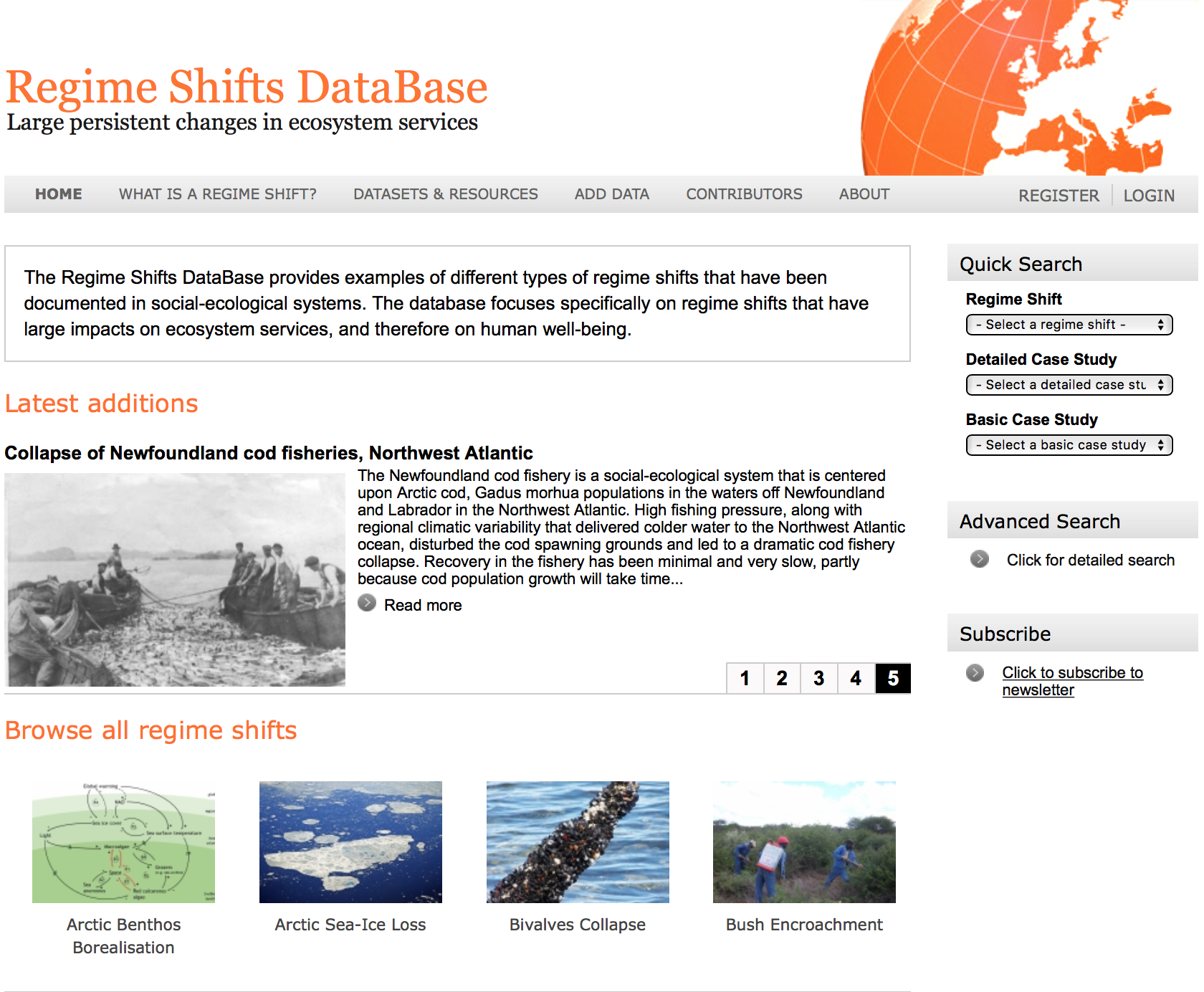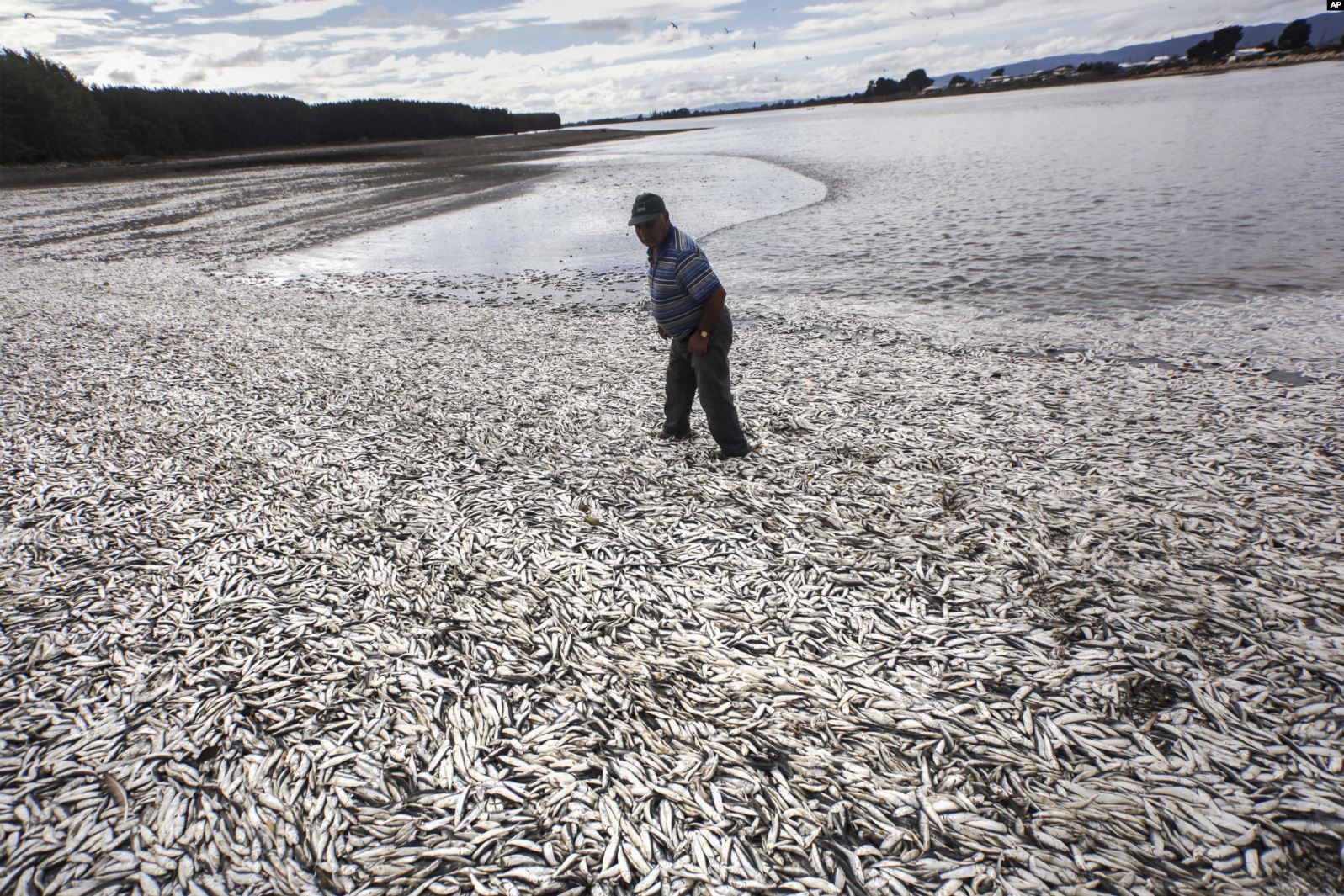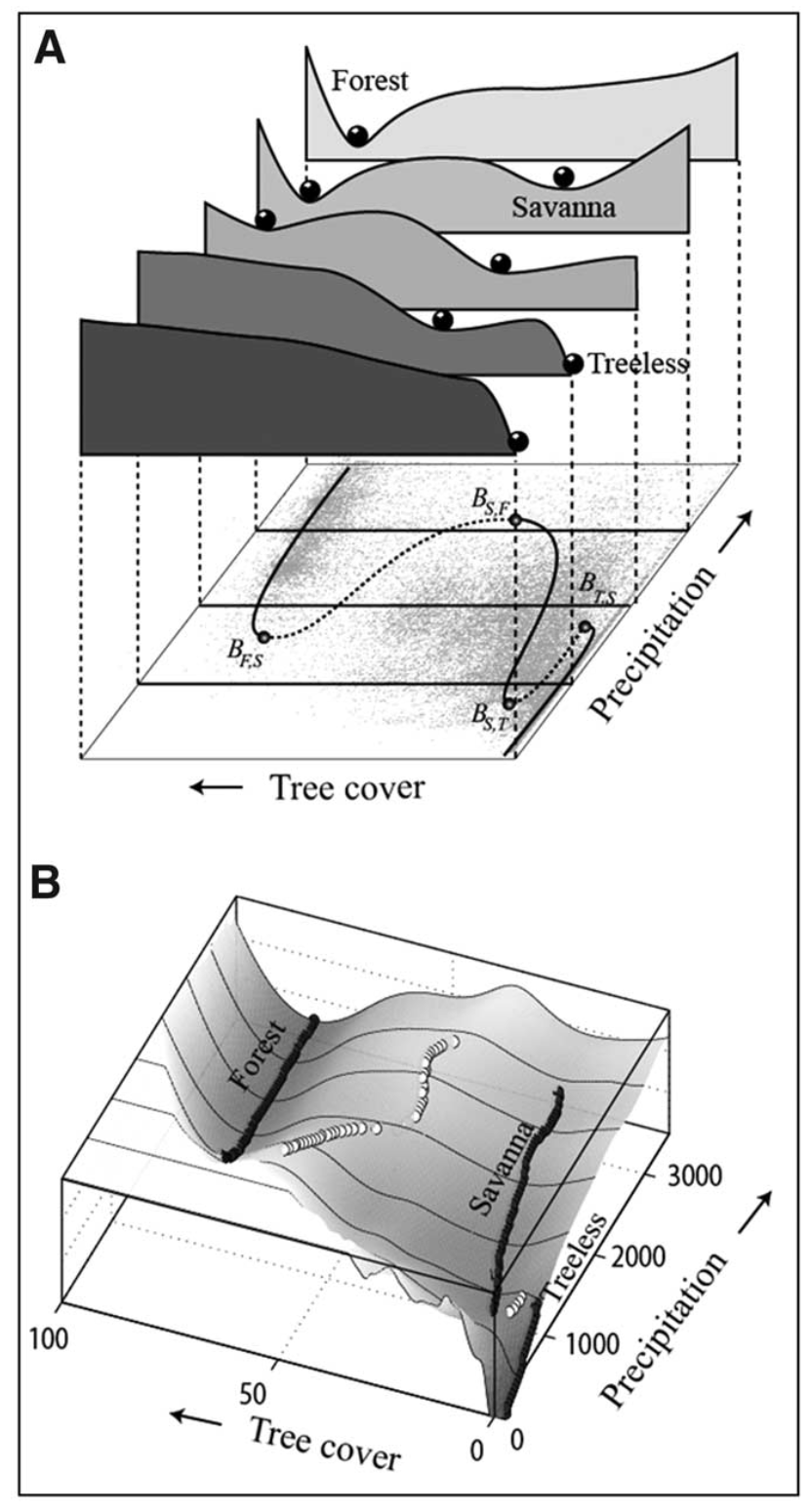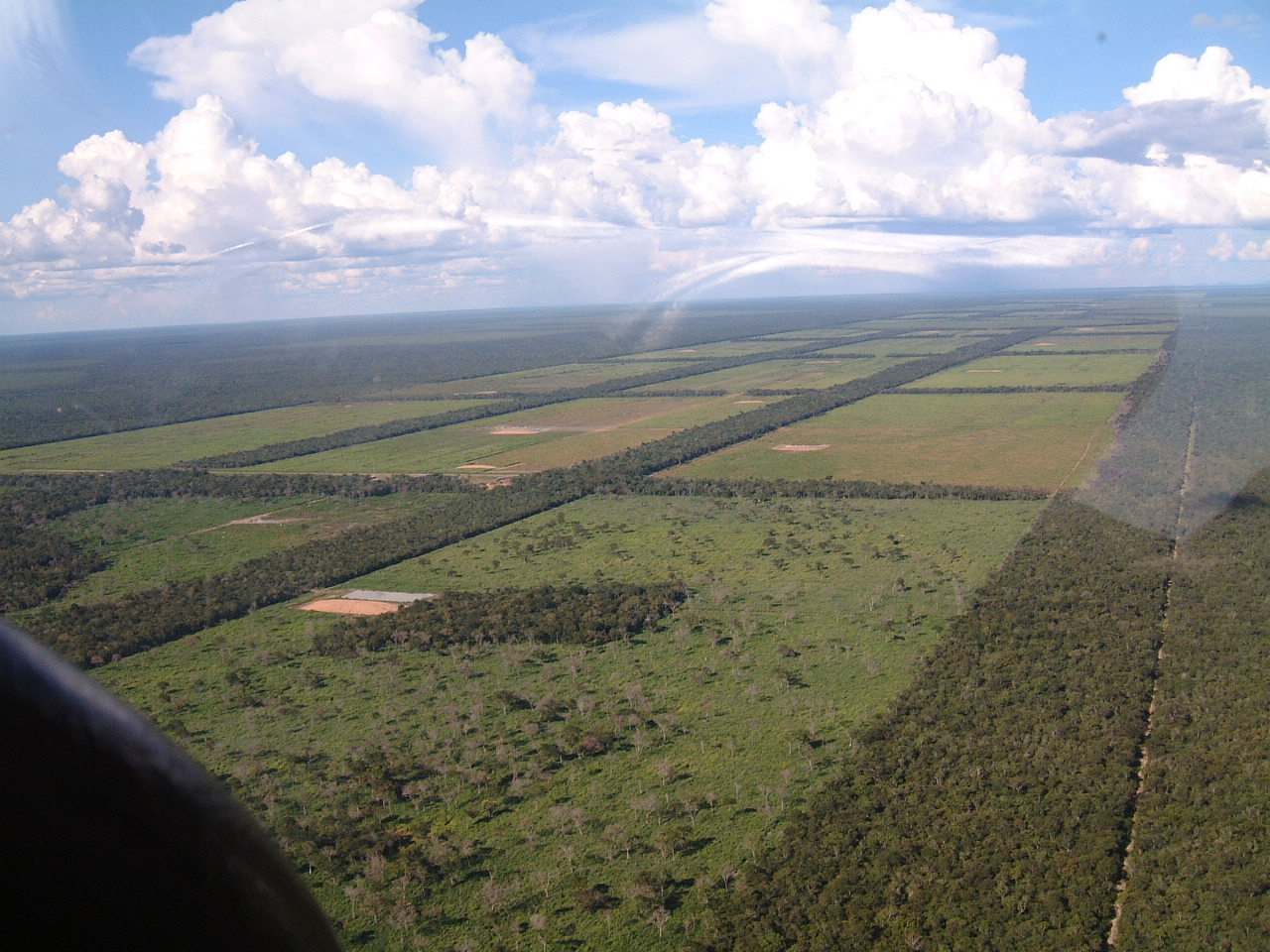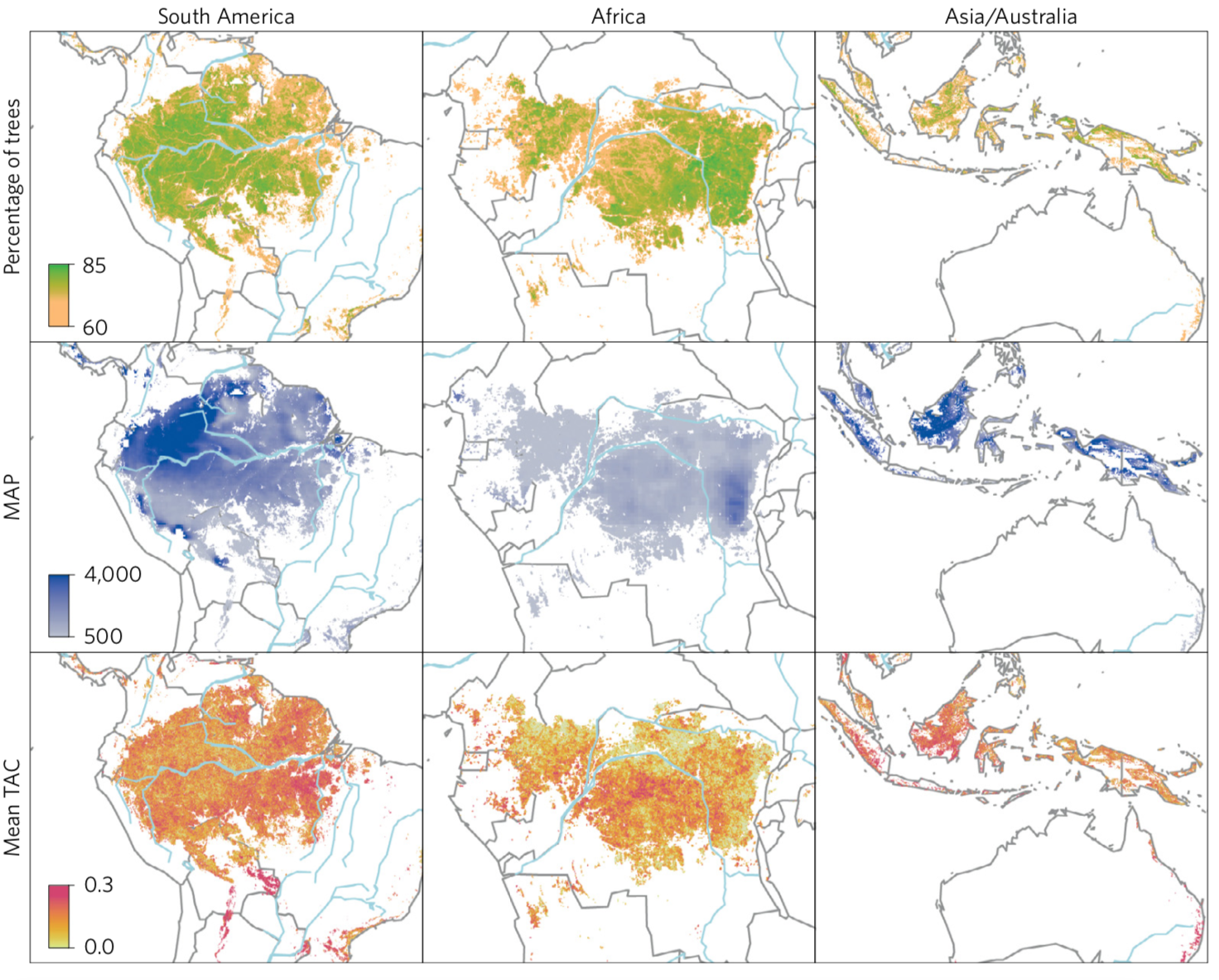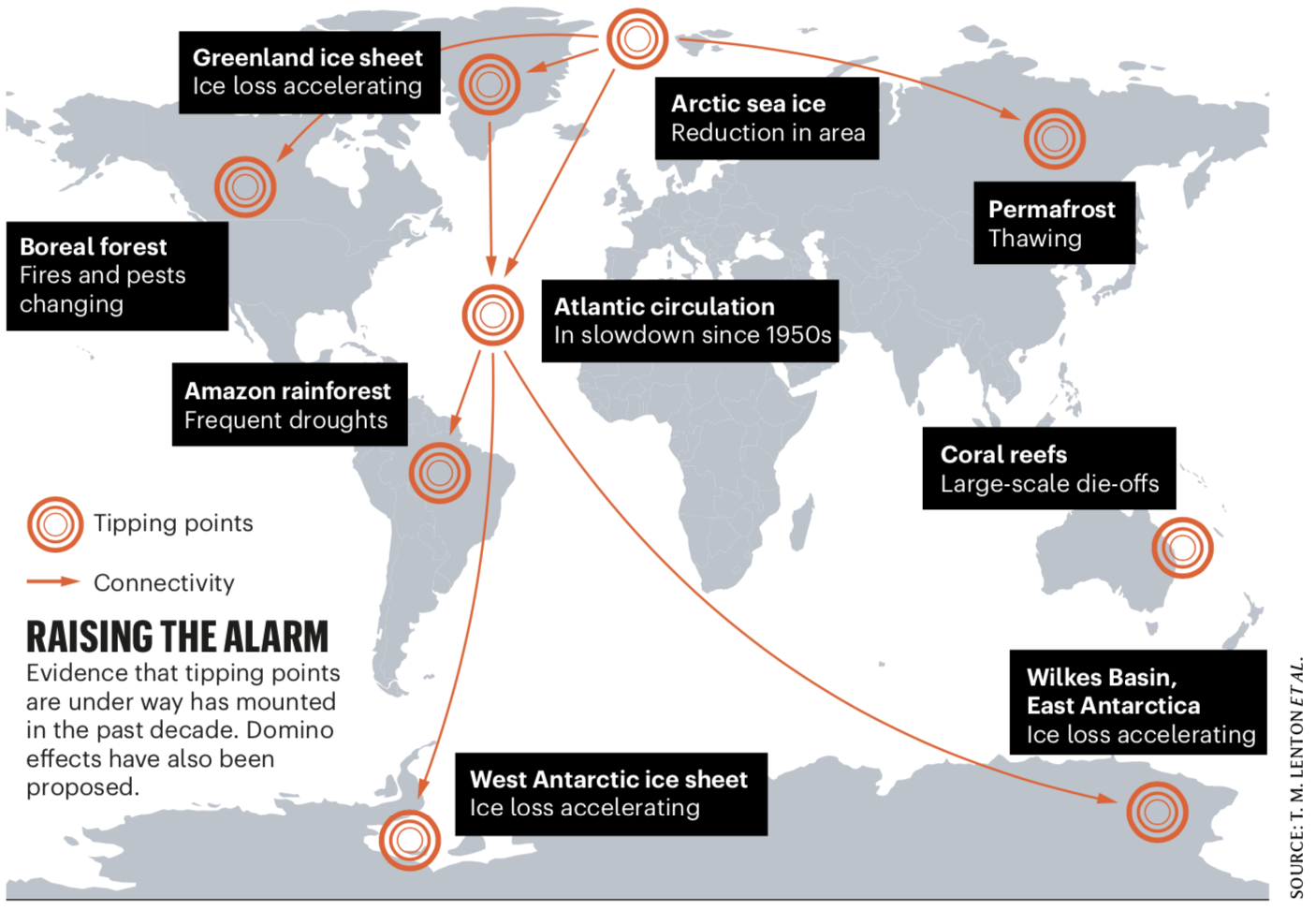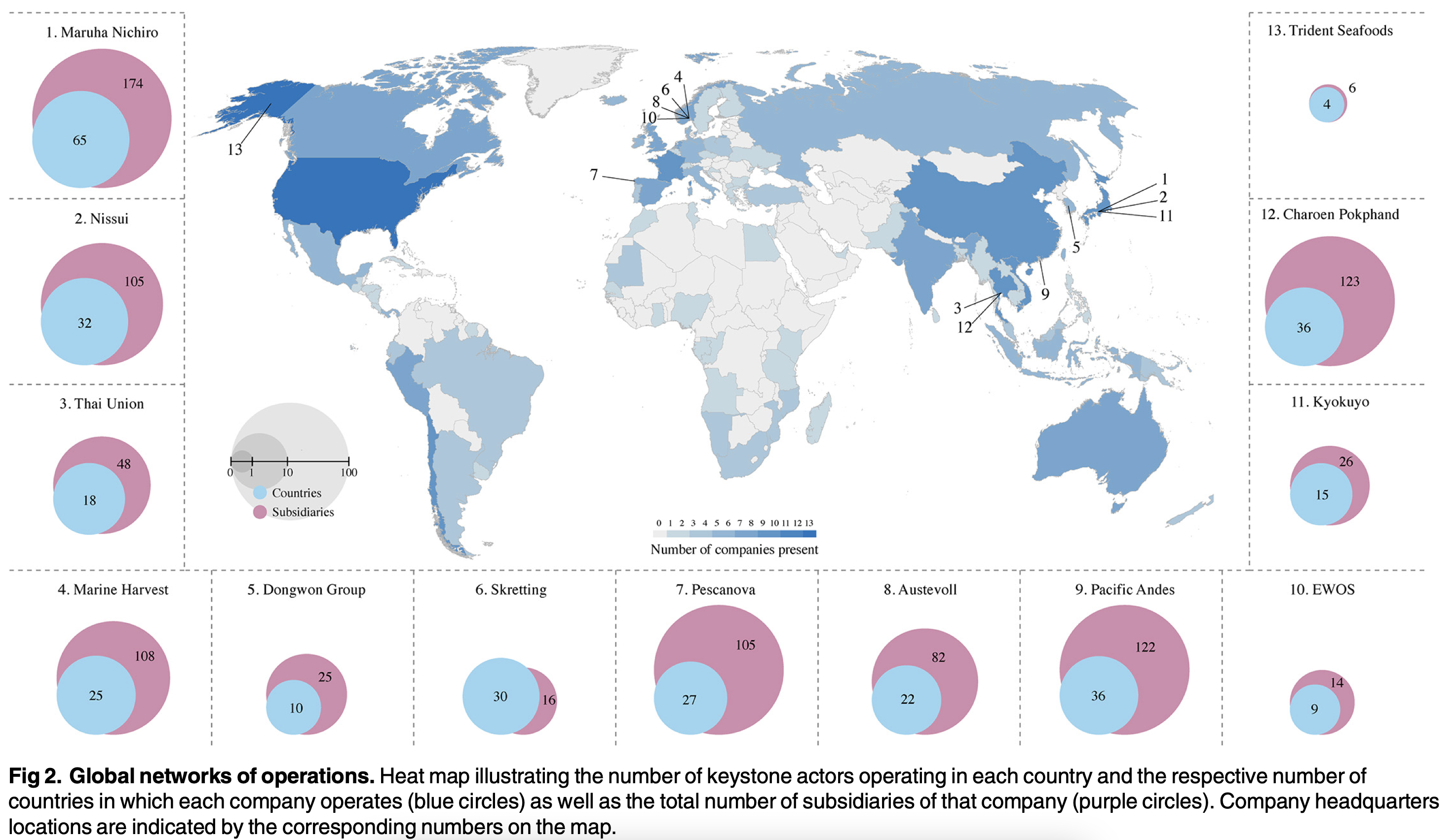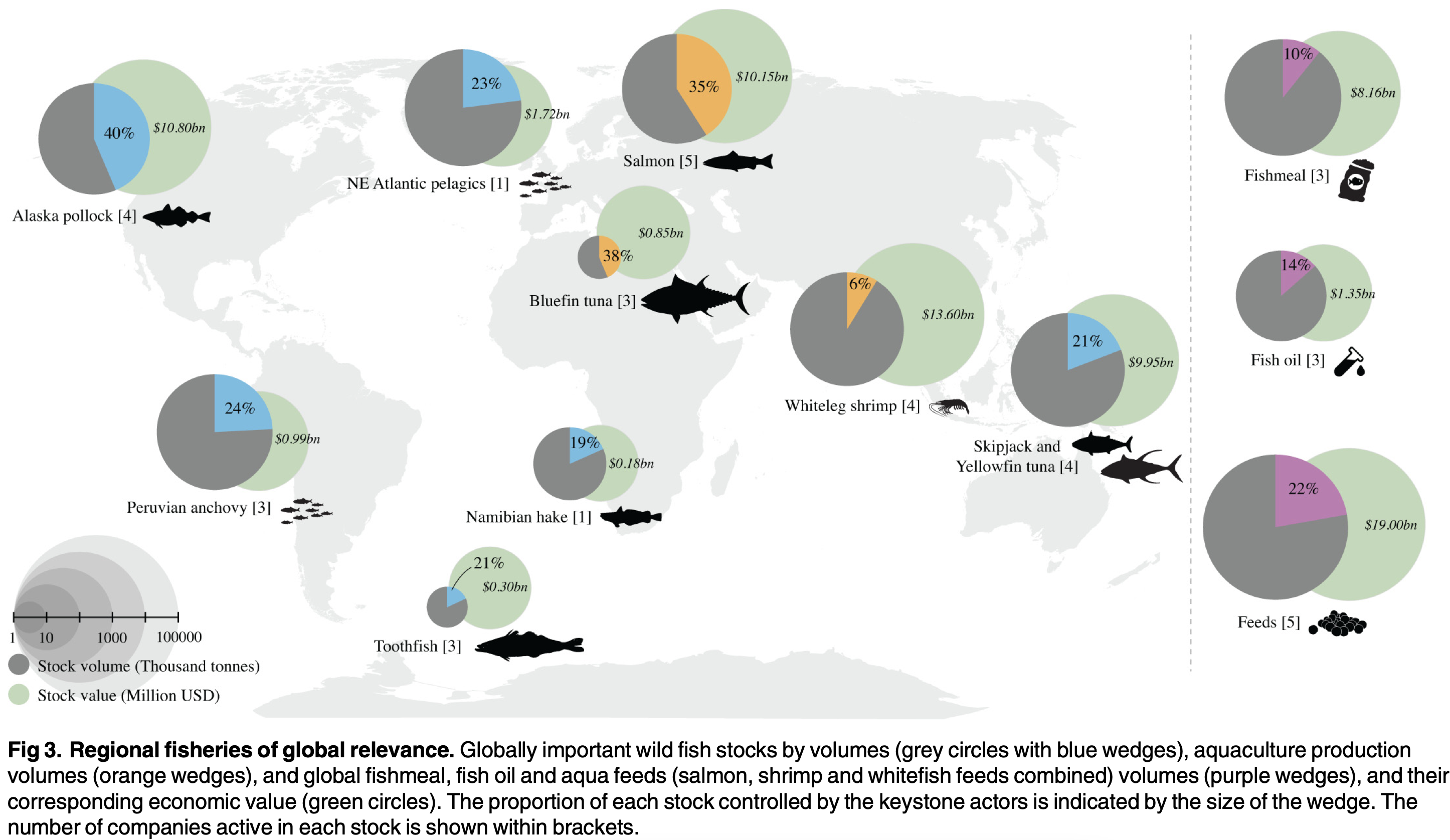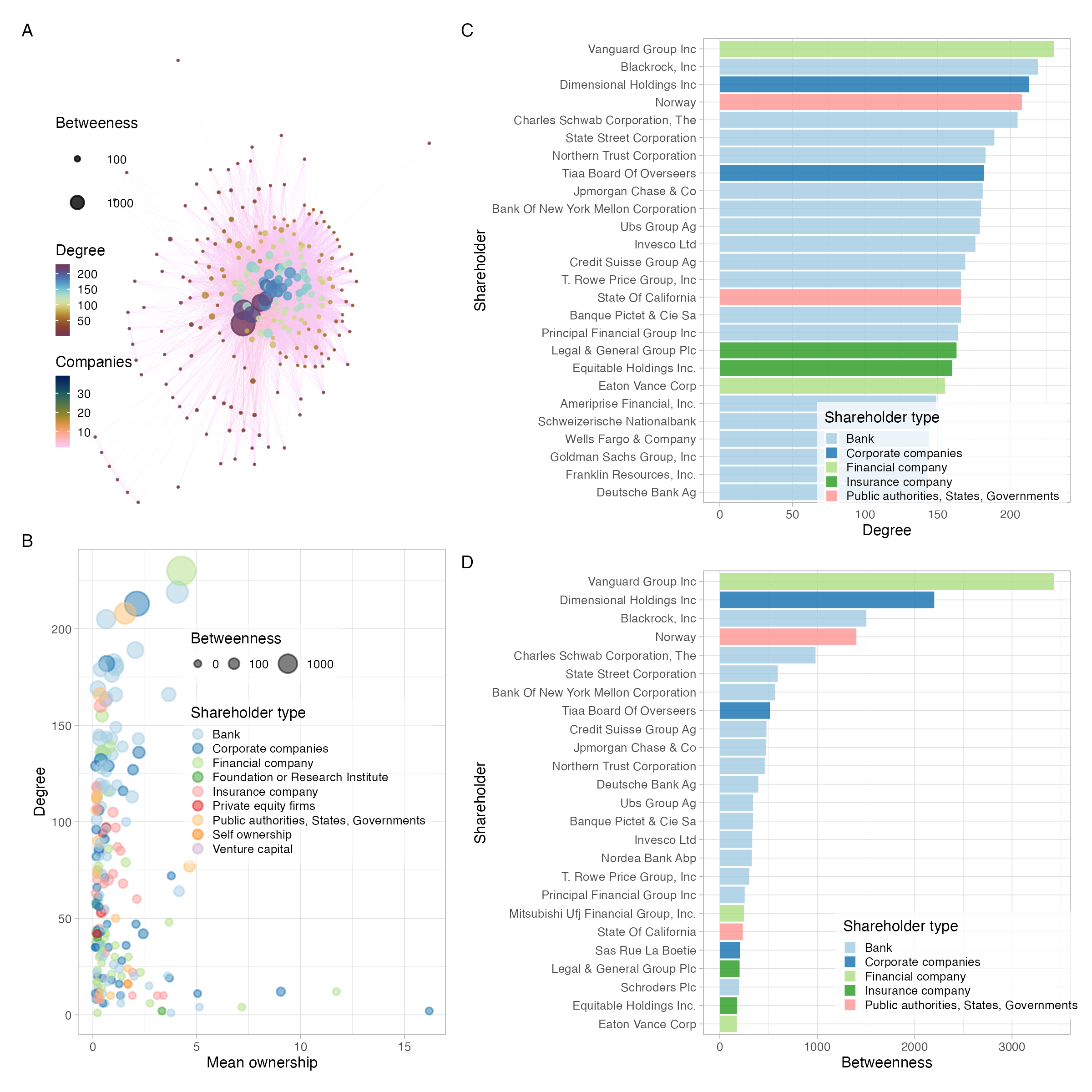- Born in Colombia
- Ecologist
- Research assistant and consultant: UniAndes, WWF, Inter American Development Bank
- MSc Ecosystems Governance
- PhD Sustainability Science
- Research interests:
- Regime Shifts
- Complex systems
- Networks
- Collective action
Tipping points and their teleconnections



About Juan
Outline
Recap:
- Resilience
- Regime shifts
Tipping points
{15 min break}
Tipping interactions & cascades
Earth stewardship
Recap
resilience | rɪˈzɪlɪəns | (also resiliency)
noun [mass noun]
1 the capacity to recover
quickly from difficulties; toughness: the often remarkable
resilience of so many British institutions.
2 the ability of a
substance or object to spring back into shape; elasticity: nylon is
excellent in wearability, abrasion resistance and resilience.
Resilience
The capacity of any system to absorb disturbance and reorganise while undergoing change so as to still retain essentially the same function, structure, feedbacks, and therefore identity
Folke, C. 2016. Resilience (Republished). Ecology and Society
Resilience
- Henri Poincaré discovered bifurcations in 1886
- Bifucations (non-linear dynamics) are foundational to studies across
natural, social sciences and humanities.
E.g poverty traps, segregation, evolution of cooperation, cancer, language, finance, climate, the states of matter, among many others. - In 1960-70s ecology: related to the meaning of stability and
catastrophe theory
(Lewontin, MacArthur, Holling, Ludwig, Walters, Noy-Meir, May)
Forest to savanna
Regime shifts are large, abrupt and persistence critical transitions in the function and structure of (eco)systems
Coral transitions
Regime shifts are large, abrupt and persistence critical transitions in the function and structure of (eco)systems
Fisheries collapse
Regime shifts are large, abrupt and persistence critical transitions in the function and structure of (eco)systems
Regime shifts history
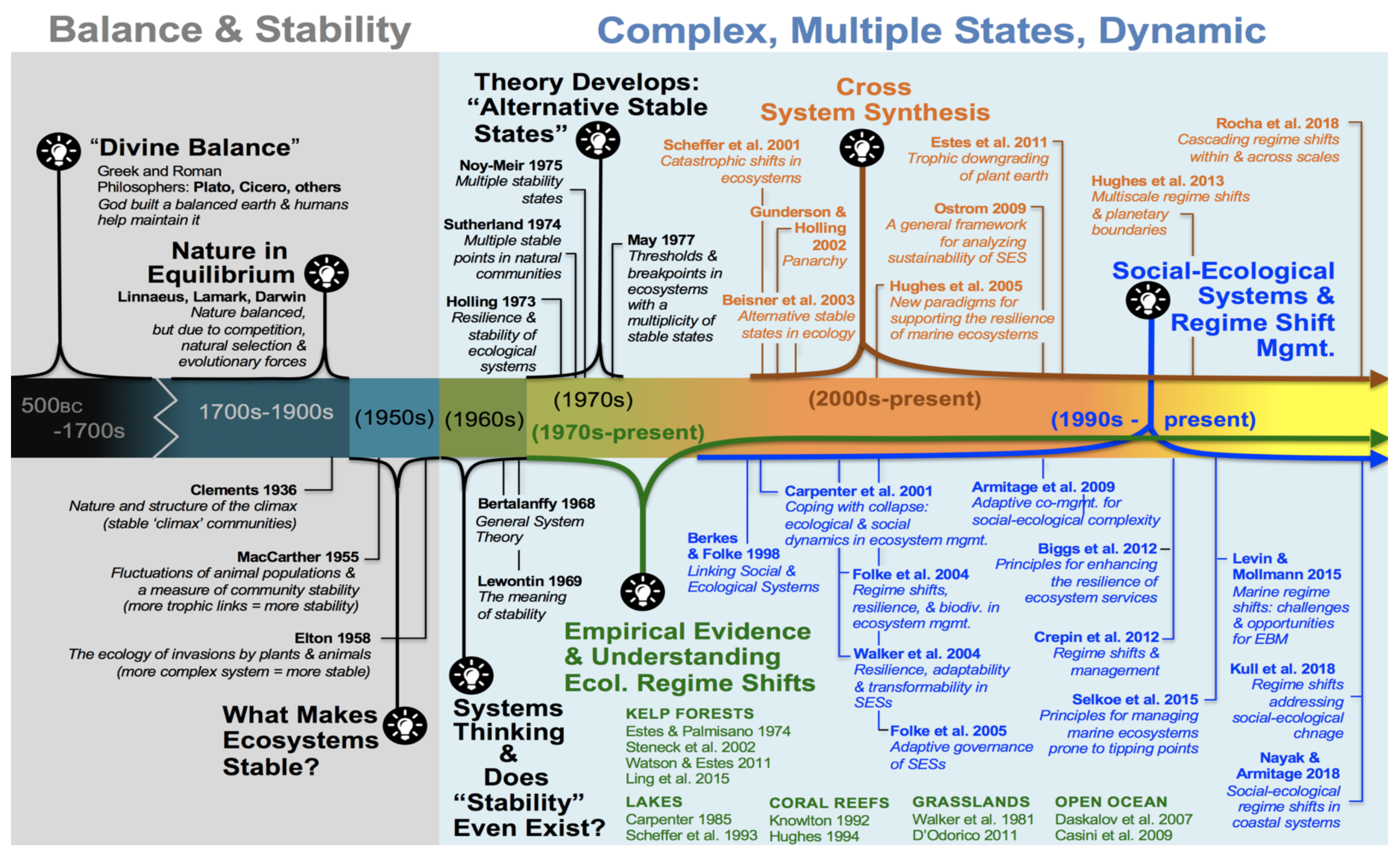
Source: Jenn Burt PhD Thesis
Hysteresis
“Hysteresis is the dependence of the state of a system on its history … rate-dependent hysteris is a dynamic lag between inputs and ouptups” —Wikipedia
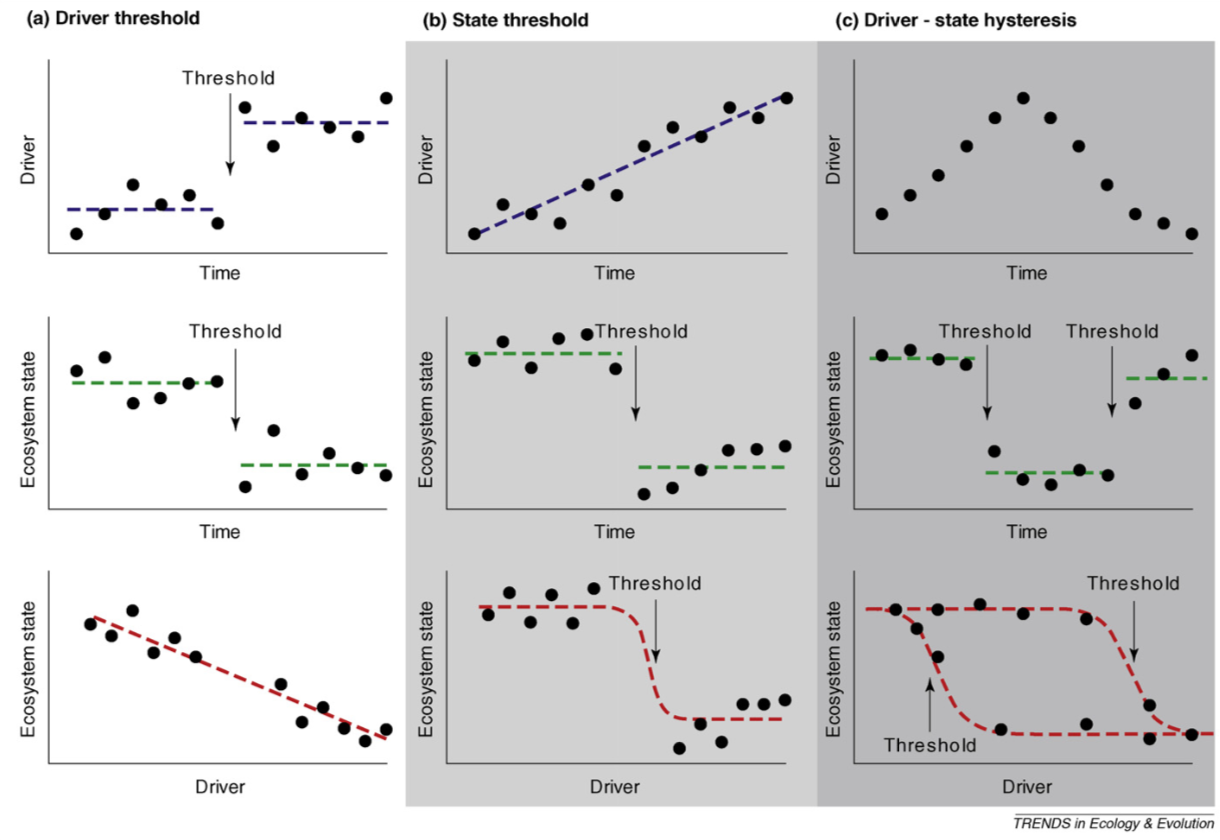
Andersen, J. et al. Trends Ecol Evol. (2009).
Abruptness affects the capacity to adapt to changes
Regime shifts and resilience
- Size of the basin of attraction
- Depth
- Slope
- Proximity to the boundary
- Property of the system or the regime (state variable)?
- Property of the disturbance?
- Resilience of what to what?
Clark, W
1975 IIASA
Menck et al
2013 NatPhys
Carpenter et
al 2001 Ecosystems
Why are regime shifts important?
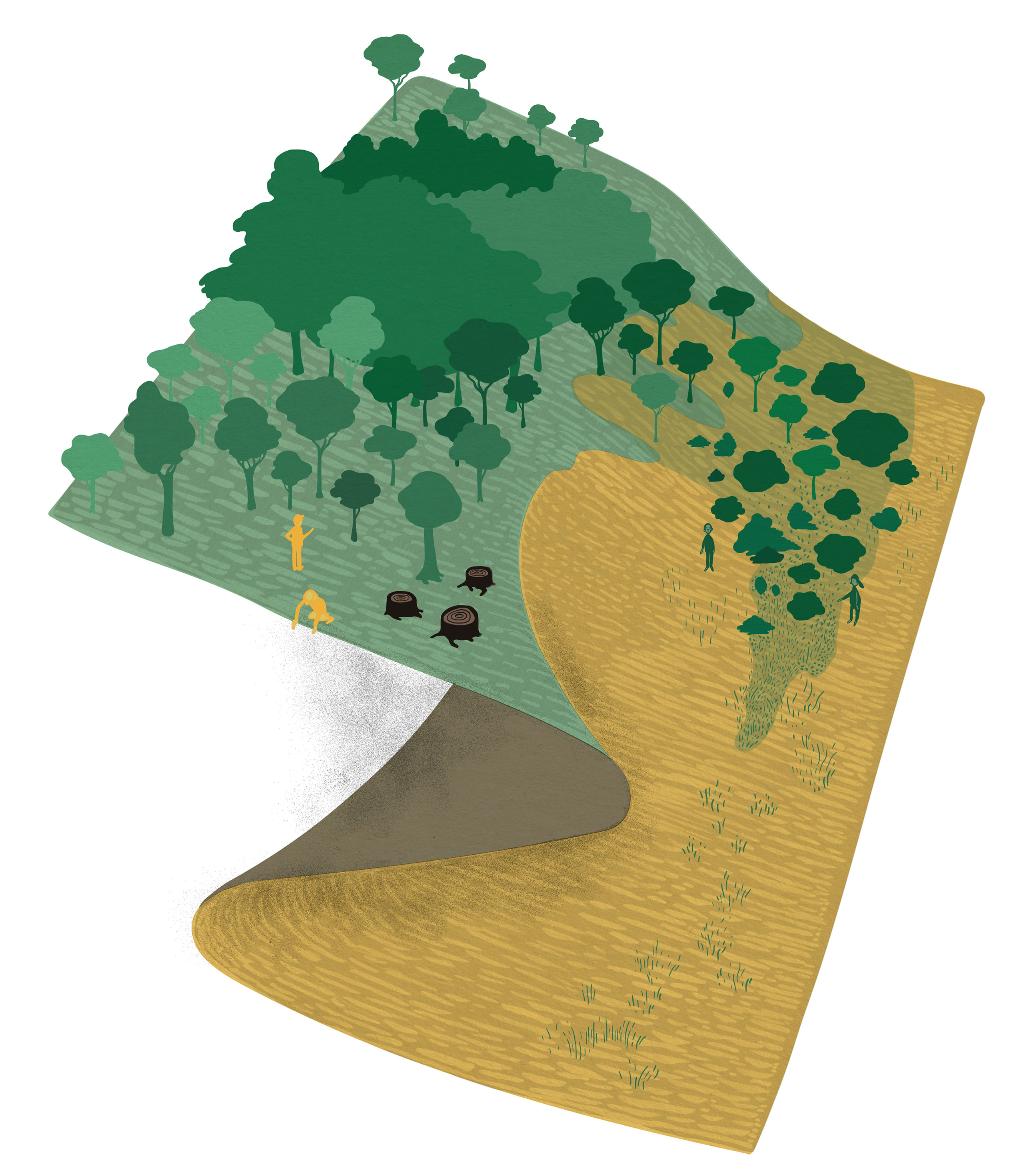
- Reduce the benefits people get from nature
- Difficult to anticipate and hard and costly to reverse
- Difficult (unethical) to perform experiments
- Often studied in isolation
- How do we compare them? Biggs et al 2018 EcolSoc
- What are their main drivers? Rocha et al 2015 PlosONE
- What are their main impacts? Rocha et al 2015 PhilTransB
The regime shifts database
How do we compare regime shifts?
Biggs et al
2018 EcolSoc
Purpose
- To provide a high quality synthesis of different types of regime shifts in SES
- To facilitate comparison
- Focus: regime shifts that have large impacts on ecosystem services i.e. matter to people
- Target audience: Scientist, assessment processes,
lecturers, students, practitioners, policy-makers
Criteria for selecting regime shifts
- Evidence of potential impacts on ecosystem services or human well-being
- Evidence of feedbacks mechanisms that reinforce different regimes
- Persists time scale relevant for society, it
matters for management
Database Structure
- Regimes
- Drivers
- Ecosystem
- Mechanism & feedbacks
- Impacts on ES and HWB
- Management options
- 75 categorical variables
- References
Database Structure
Case studies:
- Summary
- Map (coordinates)
- Categorical variables
- References

Discuss
Have you witnessed regime shifts in your life time? If so, can you give some examples? And what do you think were the causes?
05:00
Tipping points
Back to theory
d🐠d⏱️=🐠(1−🐠🌎)−🎣(🐠2🐠2+1)
Back to theory
d🐠d⏱️=🐠(1−🐠🌎)−🎣(🐠2🐠2+1)
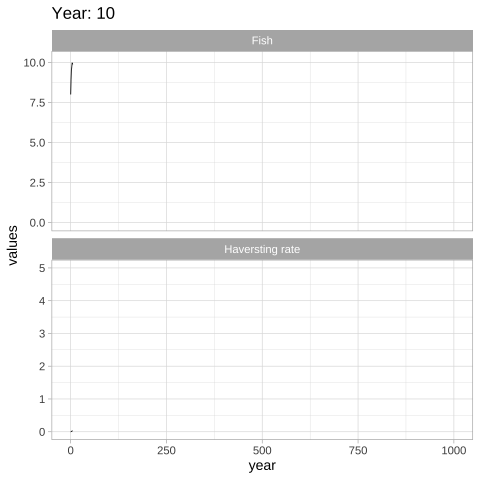
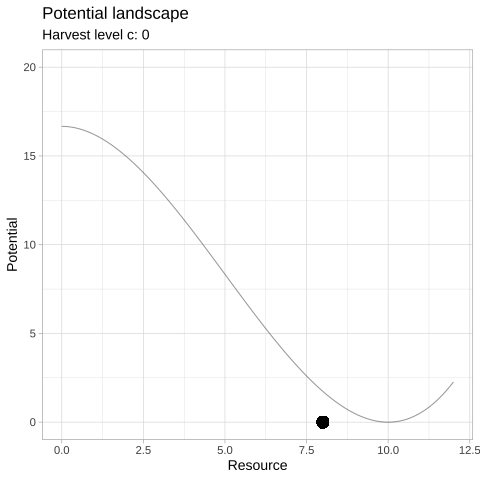
Where is the tipping point?
Where is the tipping point?
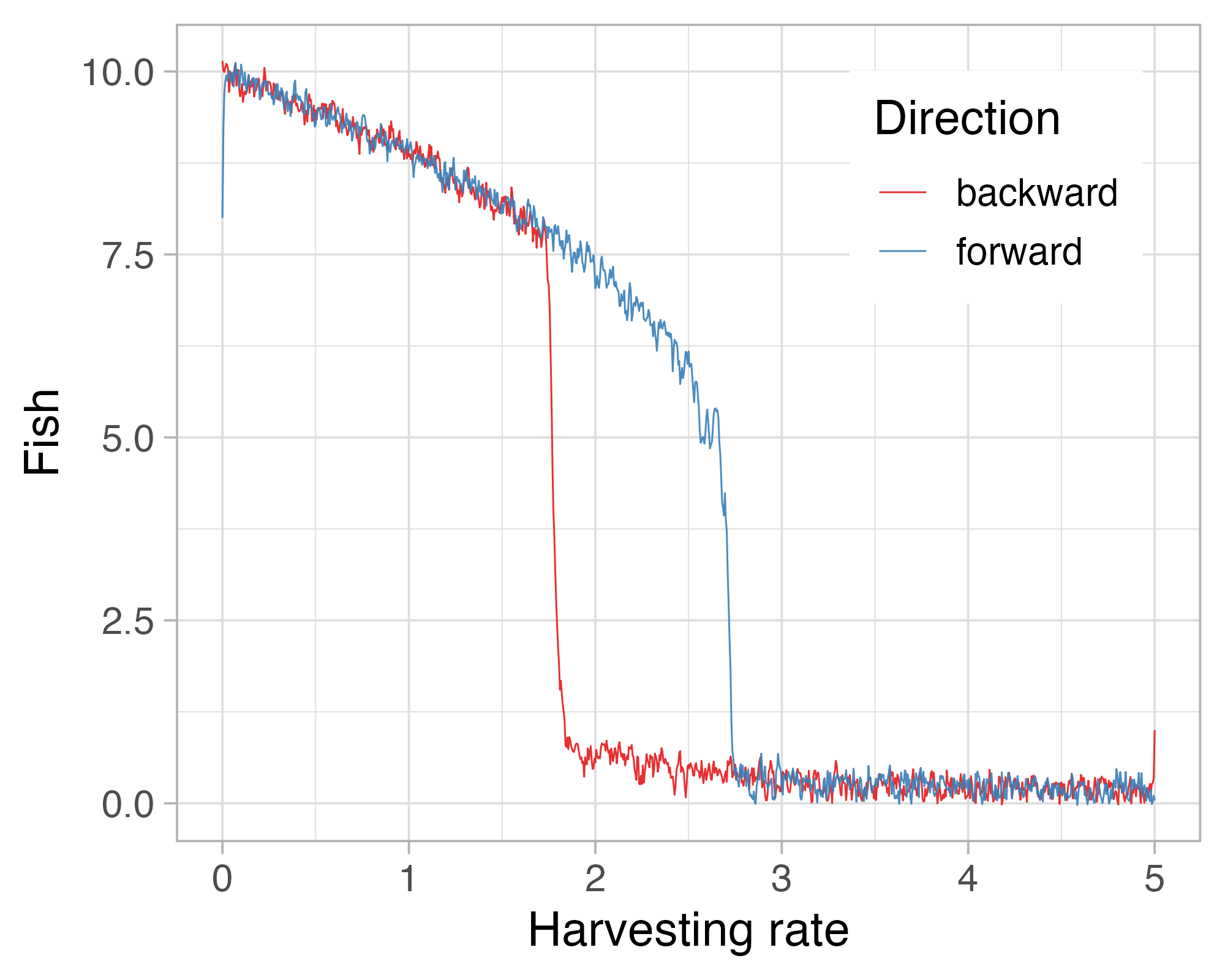
Tipping points

- Measurable and observable points at which the qualitative behaviour of the system changes
- Not people, nor events: history independent
- Clean to see in math, hard to see in the real noisy world
- Because hard to detect, some people do not find them useful e.g. Hillebrand et al 2020
Clarifications
- Tipping points are the points at which
the system tips
- Theory vs Practice
- Threshold is the separatrix between basins of attraction
- Resilience is the size of the basin
- Its neither good or bad: depends on the observer
- e.g.: The mafia is resilient (good for drug consumers, bad for police & society)
Where to find tipping points?
Climate change
To help contextualize the newly released #IPCC Report, here's 800,000 years of Earth's CO2 history in 30 seconds. pic.twitter.com/goeQYSzdhE
— Kris Karnauskas (@OceansClimateCU) August 13, 2021
Learn more: https://www.ipcc.ch
- Climate is changing, warming, at unprecedented rates in thousands of years.
- Trigger irreversible changes in the scale of centuries
- Strong reductions of CO2 can limit climate change
- 1.1∘C or warming since 1850s
- 1.5∘C: > heat waves, longer warm seasons and shorter cold seasons
- 2∘C: heat extremes, thresholds for agriculture and health
- Intensify water cycle, extreme events, sea level rise, ocean acidification and deoxygenation
IPCC interactive atlas: https://interactive-atlas.ipcc.ch
Climate tipping elements
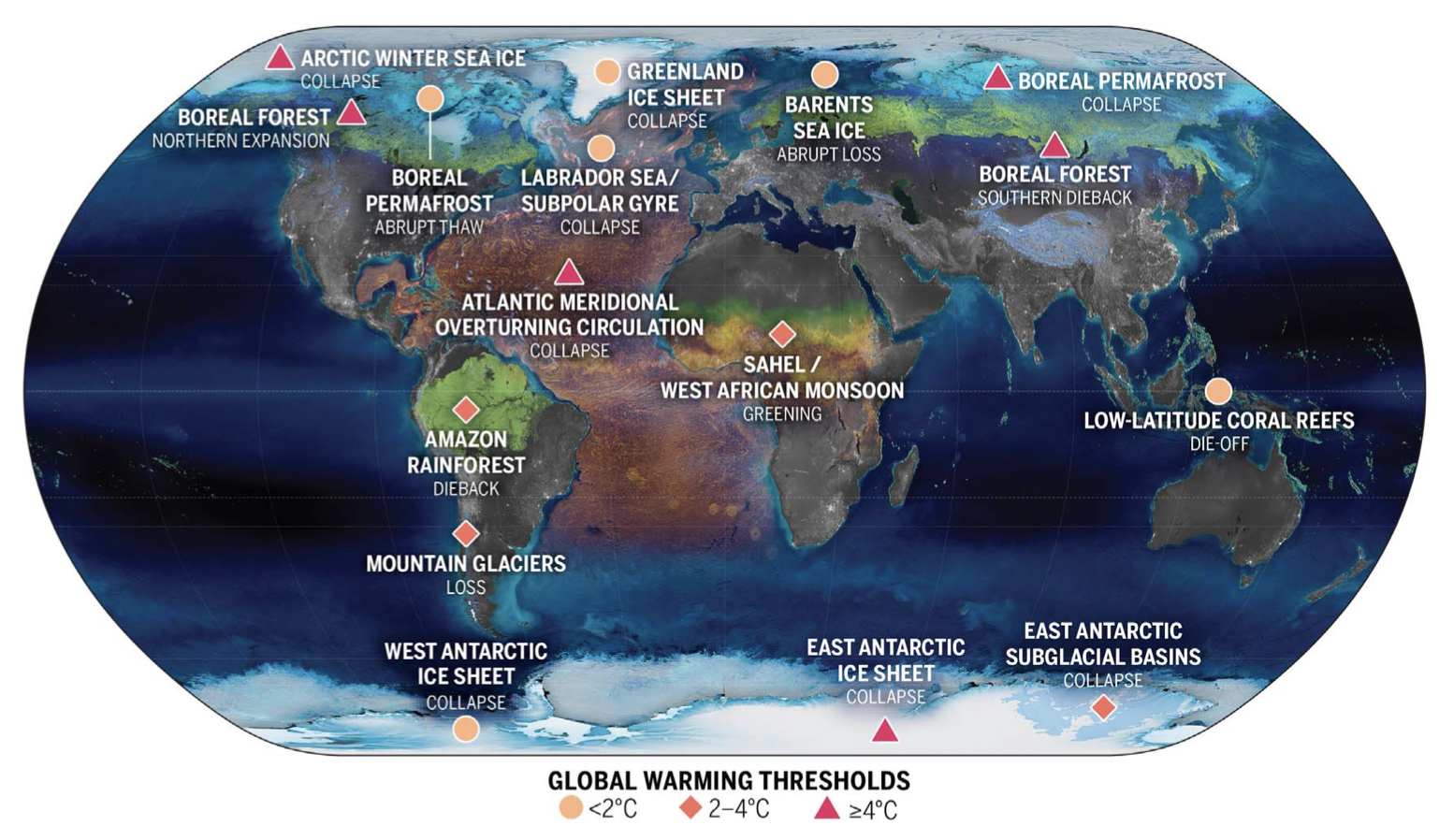
Climate tipping elements
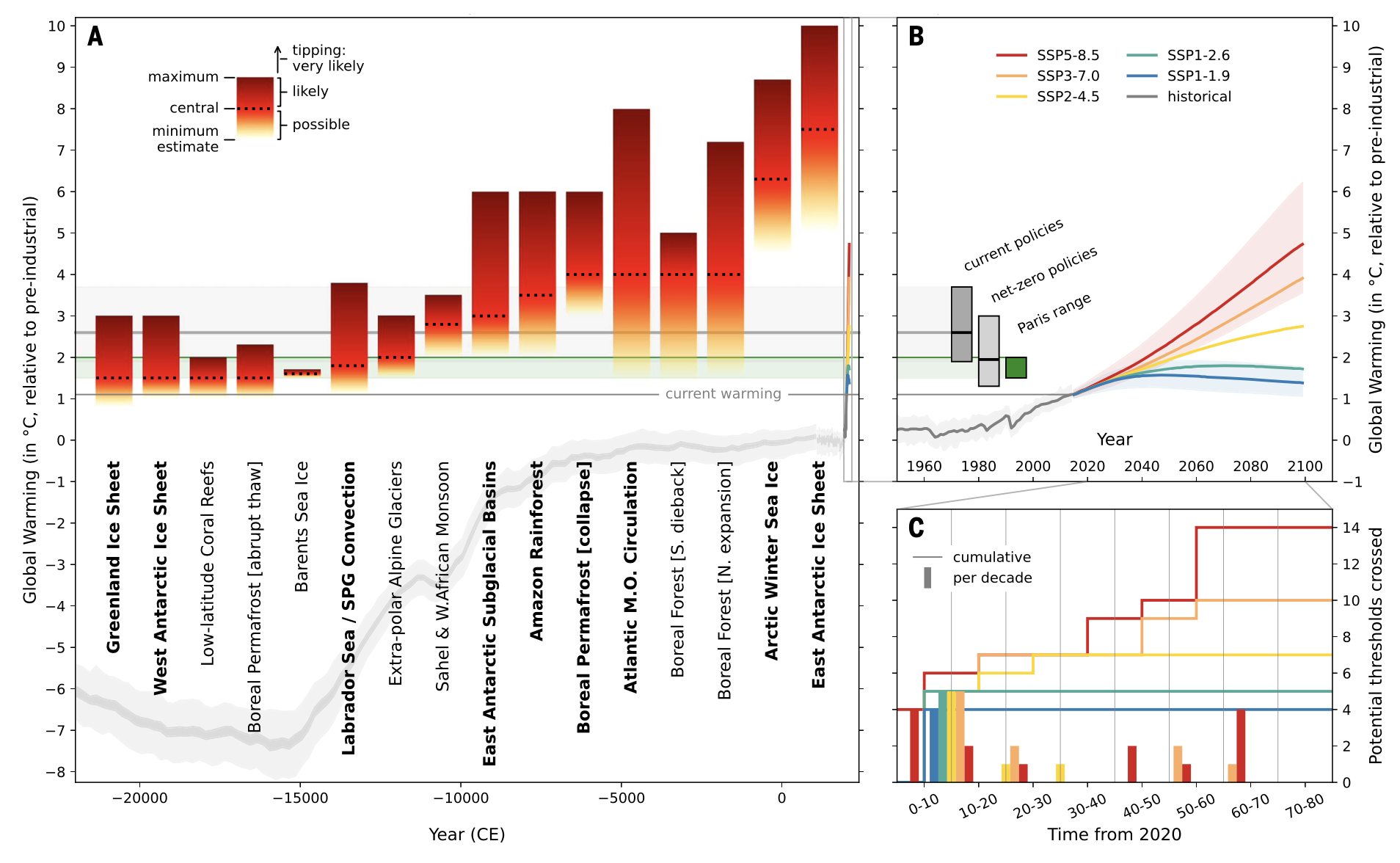
Climate is not the only one
- Drivers are nested in non-random clusters
- Food production, climate change, and urbanization are the main drivers globally
- Targeting well studied drivers wont be enough to avoid regime shifts
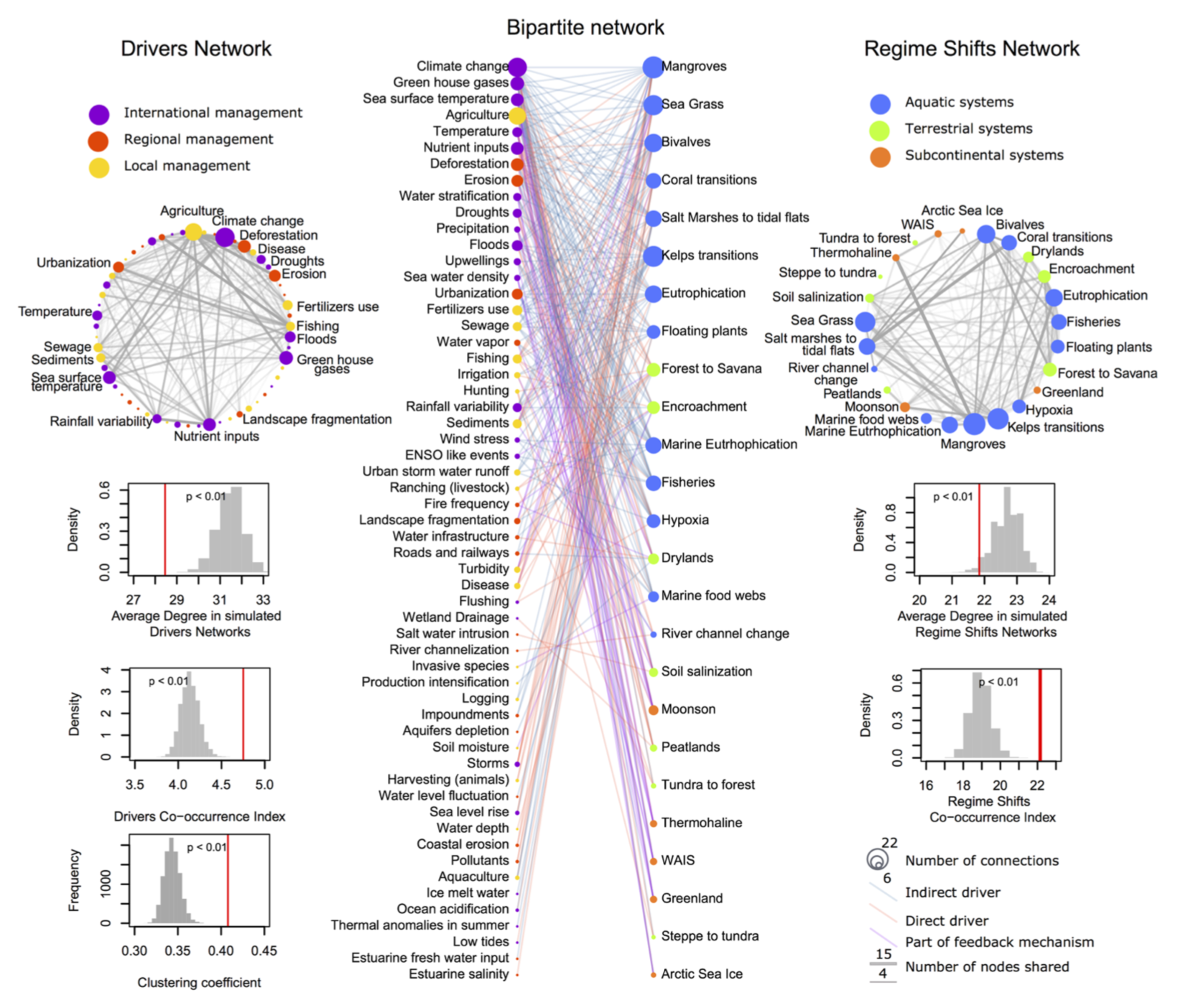
Known tipping points
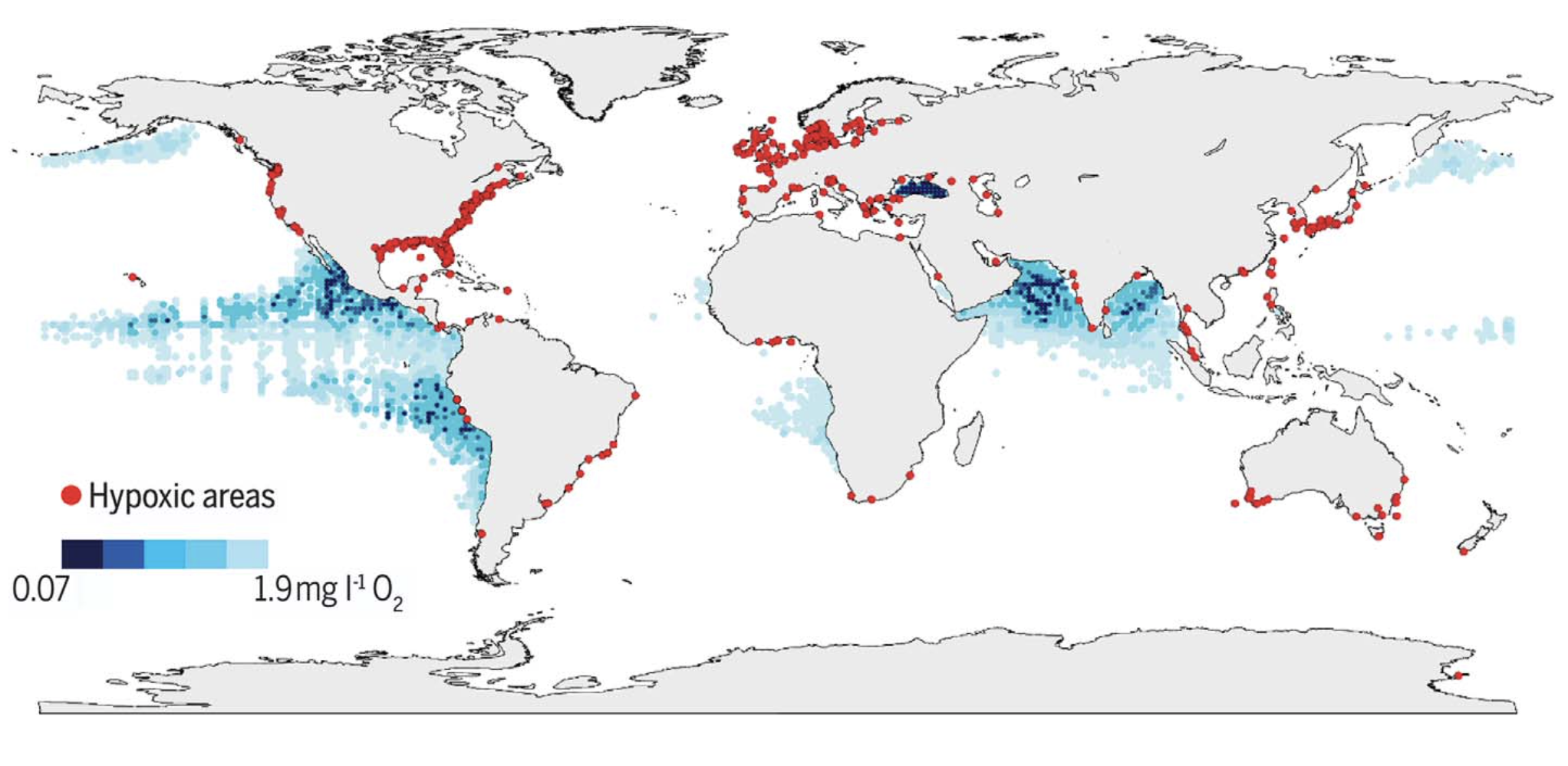
- Dissolved oxygen (mlO2/L)
- Normoxia: >2mlO2/L
- Hypoxia: ≤2mlO2/L
- Anoxia: <0.5mlO2/L
Known tipping points
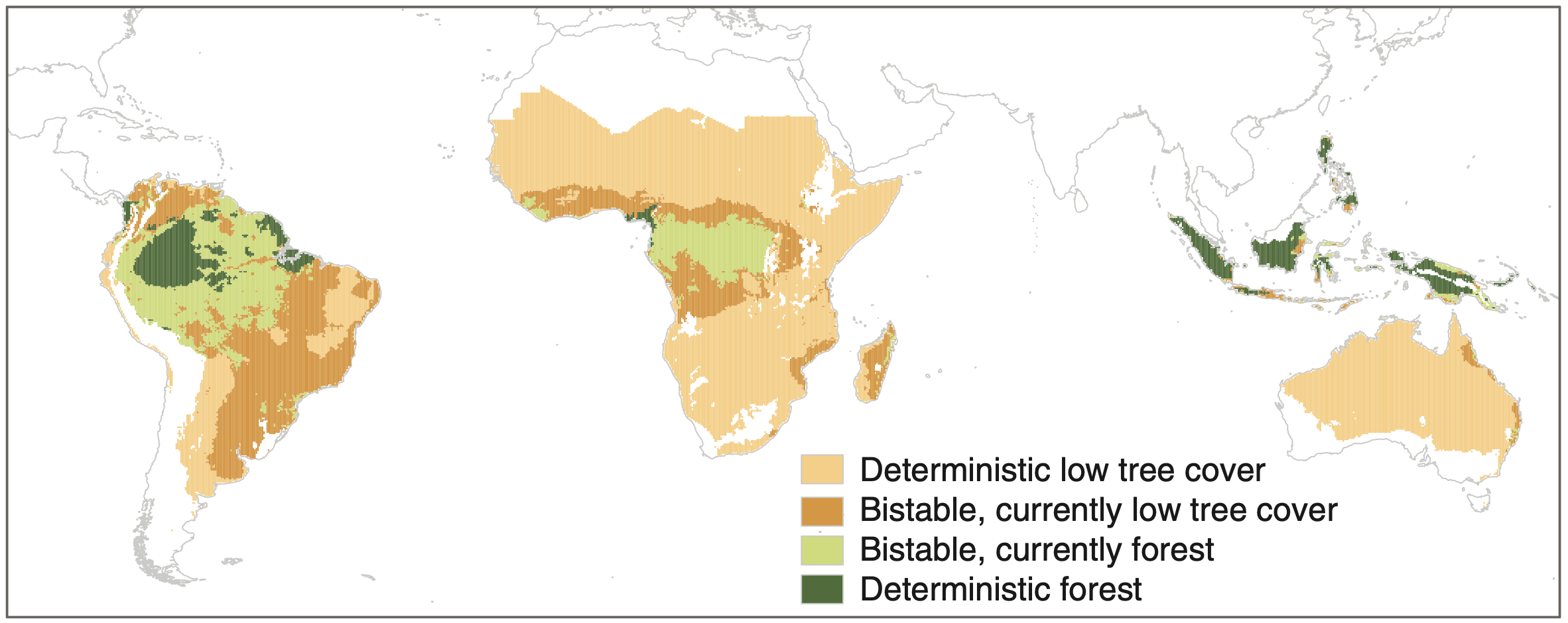
- Precipitation (mm) 🌧️
- Forest to savanna: ~1500mm
- Savanna to forest: >2000mm
- Savanna to treeless: ~500mm
Known tipping points
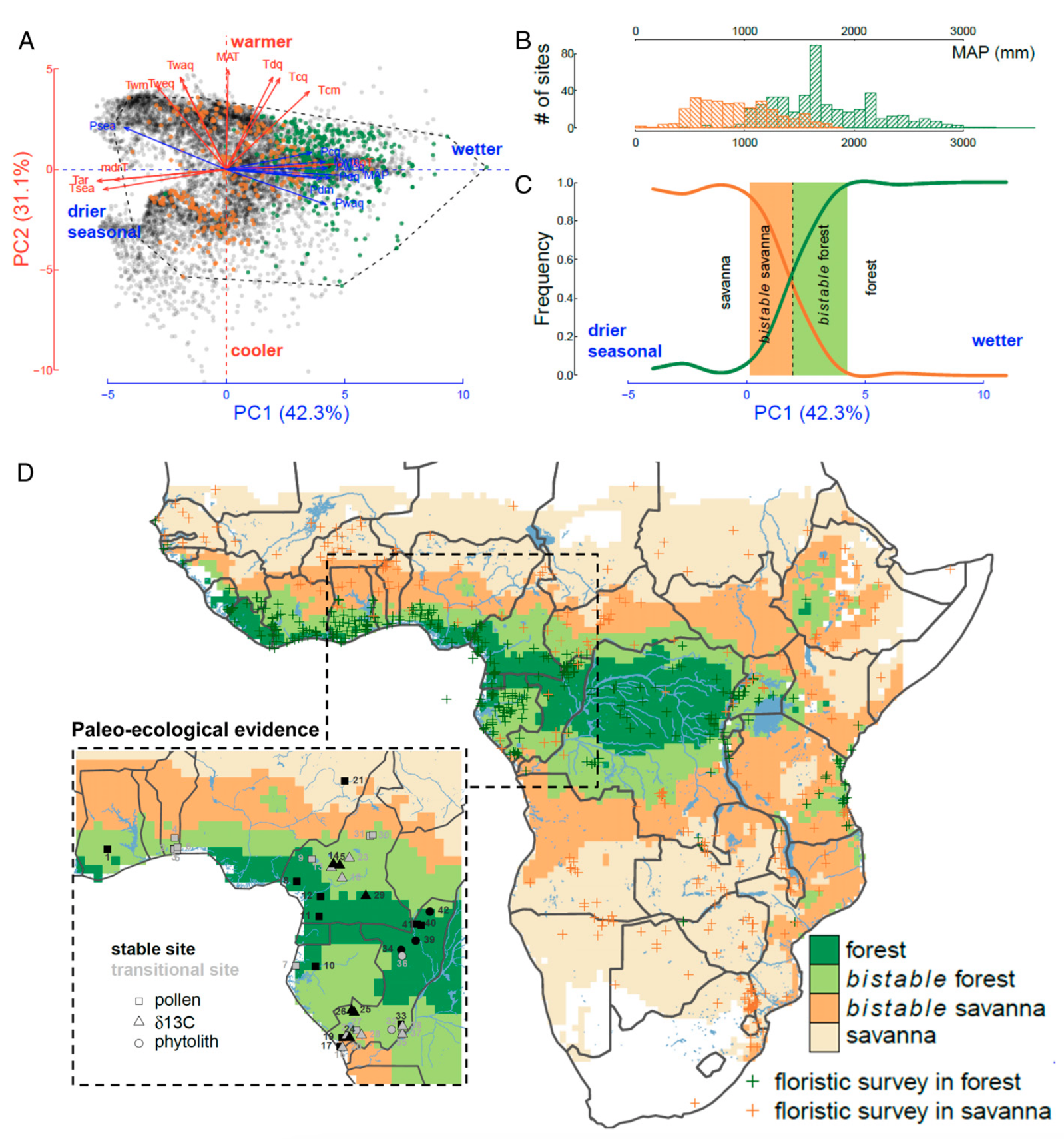
Suspected tipping points
And many others…
Break
15 minutes
Tipping points can interact
Interactions
Amazon tipping points: 3-4∘C, 1500mm rain, 40% deforestation, fire frequency?


Which will be hit first? How approaching one modifies another?
Can regime shifts be interconnected?
How crossing a tipping point could increase the likelihood of other ecosystems tipping over
How do regime shifts interact?

Whether the occurrence of one will increase the likelihood of another, or simply correlate at distant places
Conceptual and theoretical work
- Tipping can hop between systems: X→Y→Z
Brummit 2015 - Coupled tipping systems do not leave early warning signals Dekker 2018
- Some network motifs (feedforward loops) can destabilize tipping cascades Krönke 2020, Wunderling 2020
Regime Shifts Database
- To provide a high quality synthesis of different types of regime shifts in SES
- To facilitate comparison
- Focus: regime shifts that have large impacts on ecosystem services i.e. matter to people
- Target audience: Scientist, assessment processes, educators,
practitioners, policy-makers
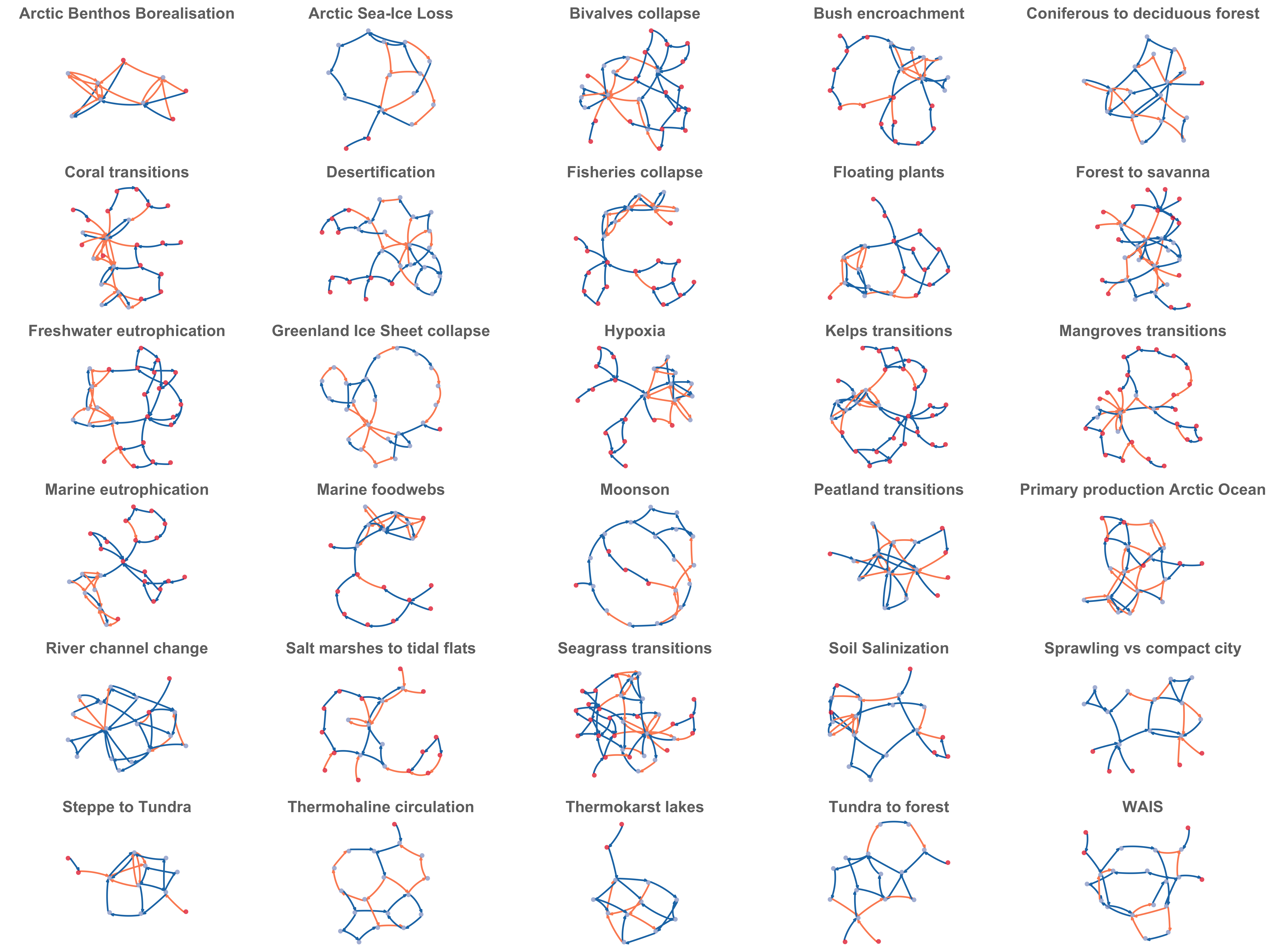
Source: Regime Shifts Database
Method
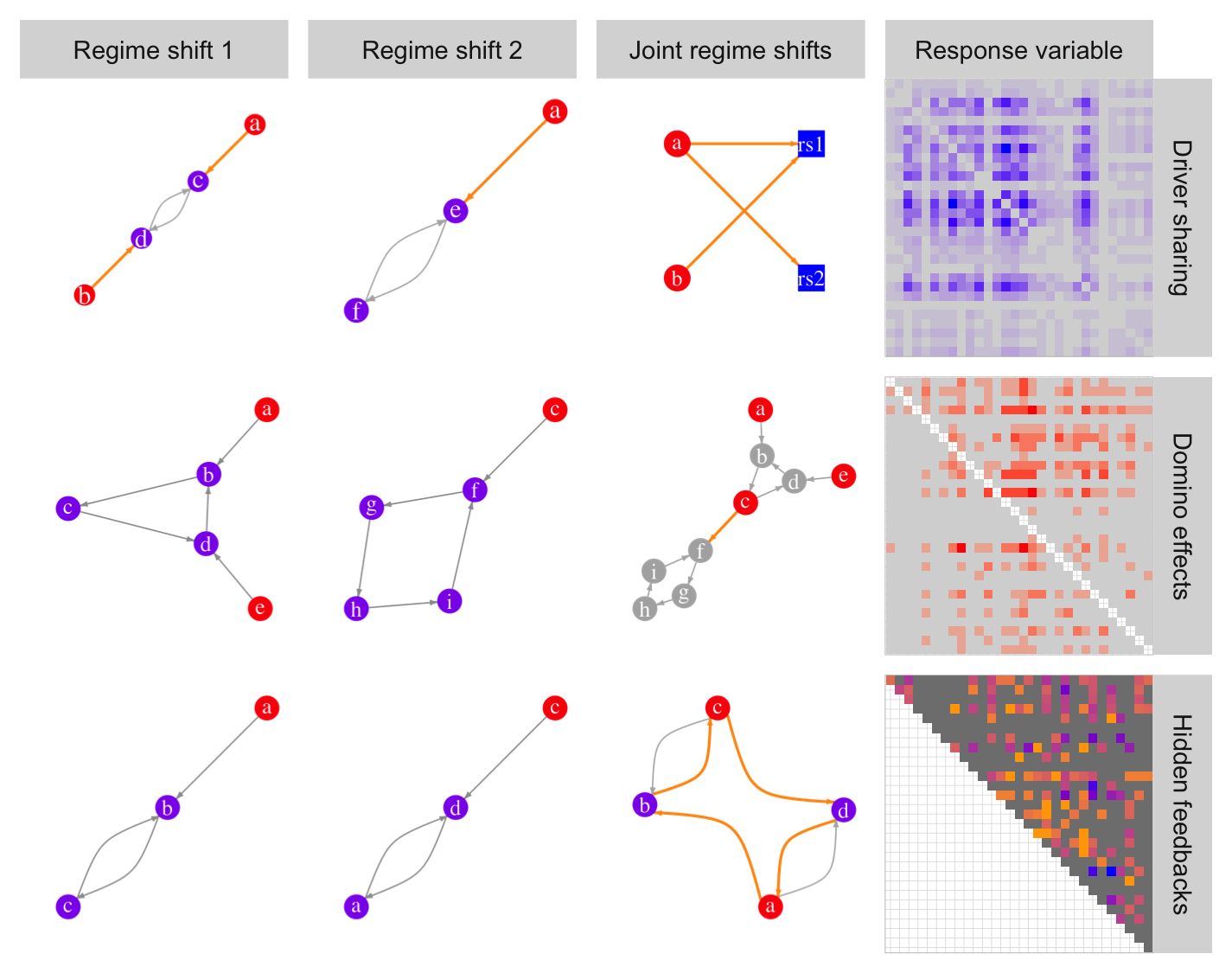
Rocha, J, et al . Cascading regime shifts within and across scales. Science 362, 1379–1383 (2018)
A worked example

Cascading effects
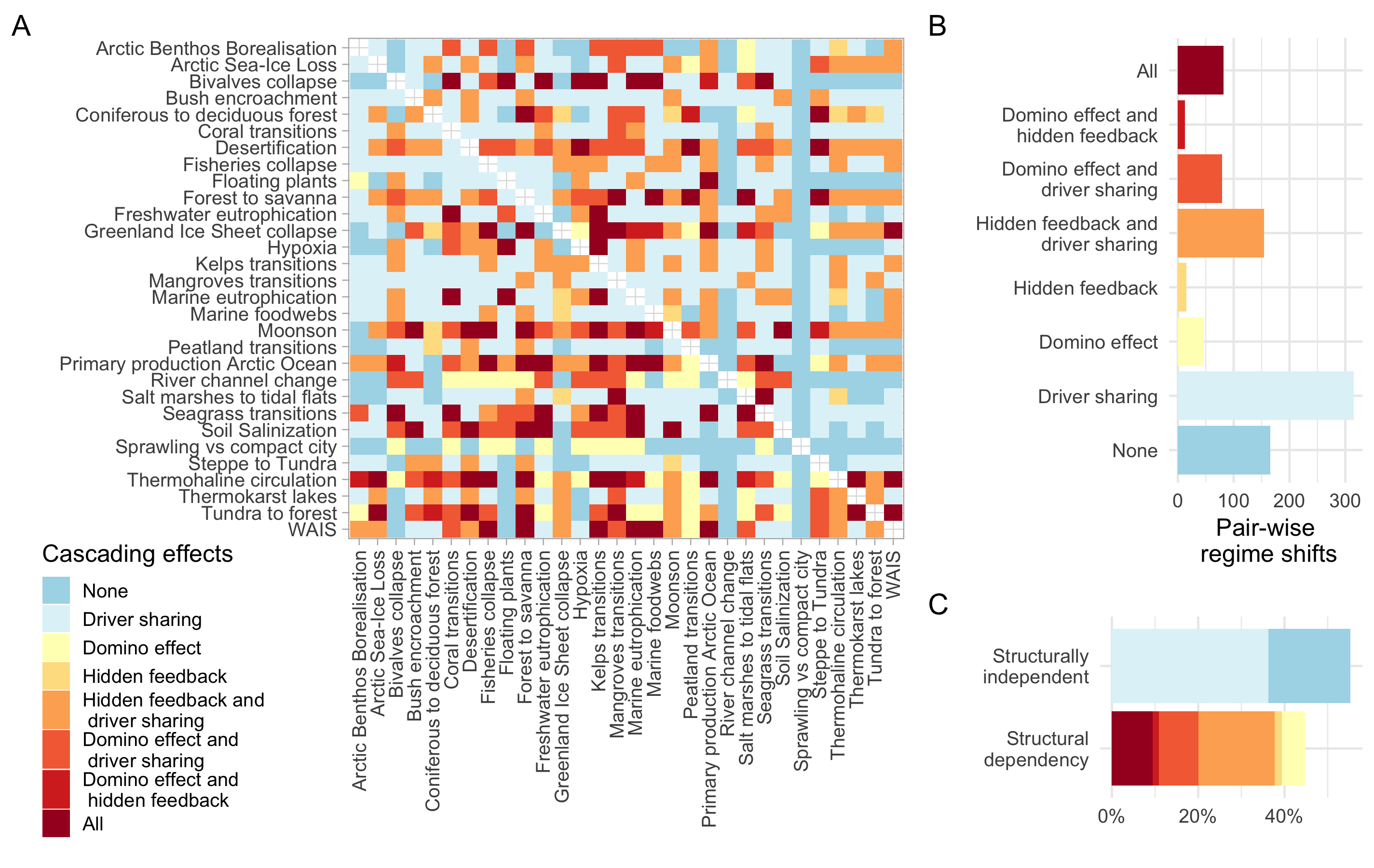
~45% of the regime shift couplings analyzed present structural dependencies in the form of one-way interactions for the domino effect or two-way interactions for hidden feedbacks
Driver sharing
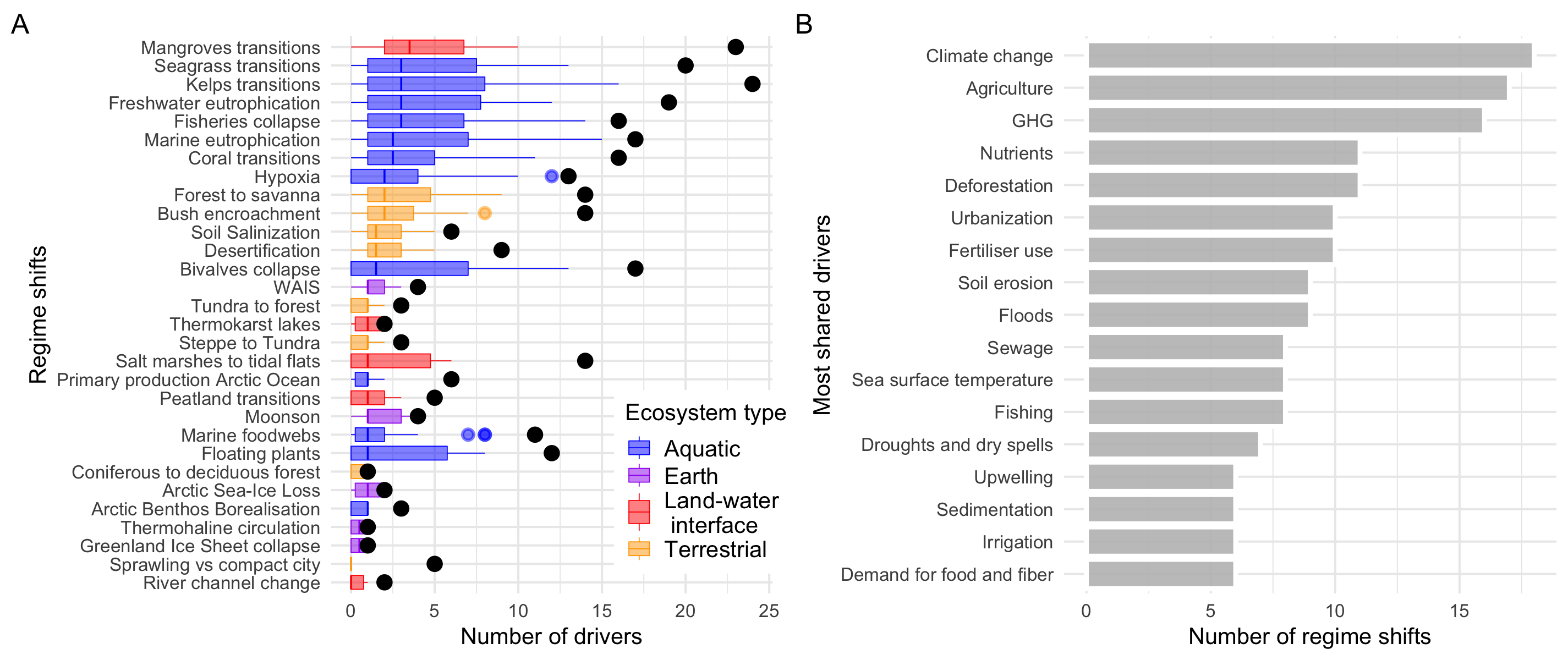
Aquatic regime shifts tend to have and share more drivers. The most co-occurring drivers are related to food production, climate change & urbanisation. 36% of pair-wise combinations are solely coupled by sharing drivers
Domino effects
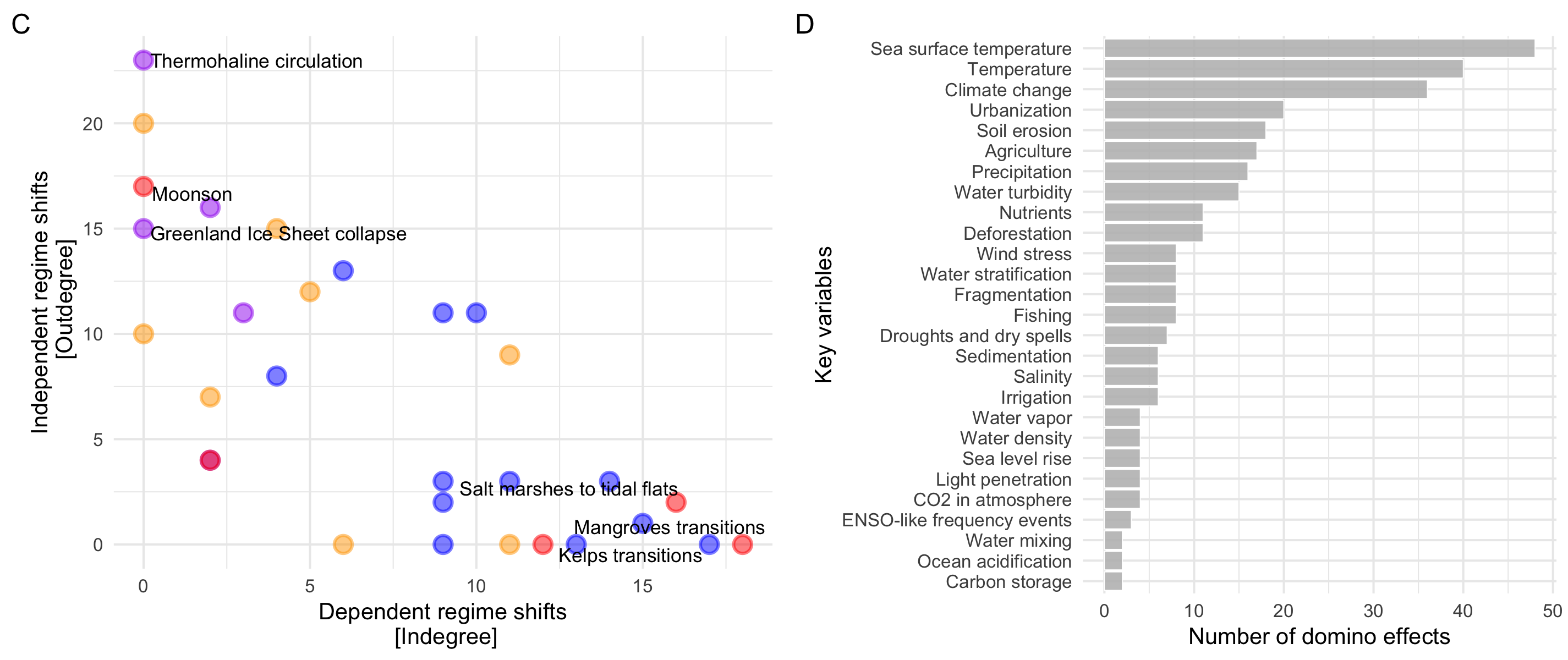
Evidence of cross-scale interactions for domino effects was only found in space but not in time. The maximum number of pathways found was 4, and the variables that produce most domino effects relate to climate, nutrients and water transport
Hidden feedbacks
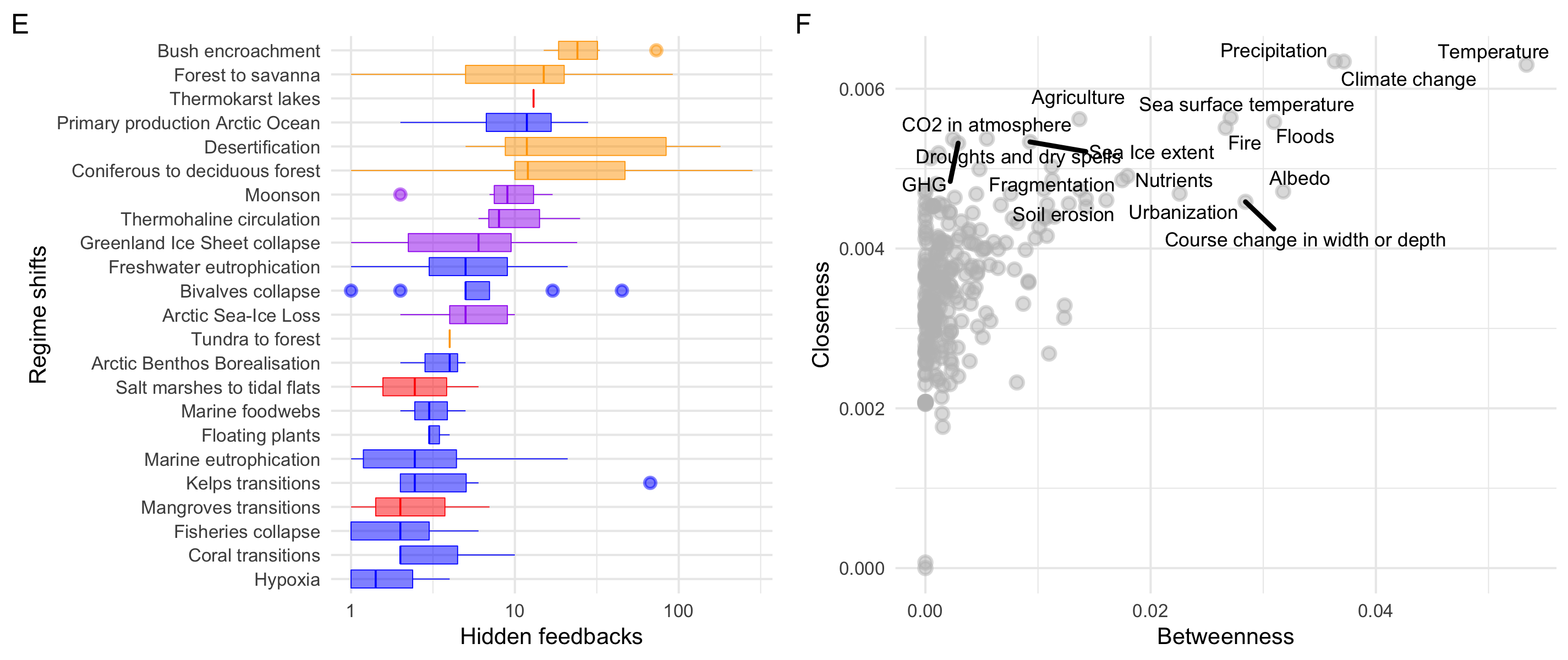
Most hidden feedbacks occur in terrestrial and earth systems. Key variables that belong to many of these hidden feedbacks are related to climate, fires, erosion, agriculture and urbanisation
Trivia
What is your favorite take home message from their work?
05:00
Why does it matter? Earth Stewardship

Who has the agency to make a difference?

- “Zoonotic EID risk is elevated in
forested tropical regions experiencing land-use changes and where
wildlife biodiversity is high” Allen et al
2017
- Companies who extract natural resources
- Shareholders who invested in them
- Networks of shareholders with common investments
Why does it matter? Earth Stewardship
- How tipping points are interconnected can amplify or dampen cascading effects: network structure matters
- It can empower countries, cities or businesses to do their part: emphasize agency
- It can re-draw the geopolitical map of the world: with whom do you need to cooperate to avoid synchronous crises?
Regime shifts can be interconnected
- Climate is a central mechanism, but not the only one. Other mechanisms can trigger tipping cascades earlier than climate
- Multiple mechanisms means multiple opportunities for intervention
- Empirical evidence is missing: which connections are more relevant? what interventions has potential to slow down tipping cascades?
Where on Earth are regime shifts likely to occur?
Depends on our ability to observe and measure resilience
Data & methods
- ↑ Variance and autocorrelation
- Δ skewness and kurtosis
Dakos et
al. 2012. PLoS ONE
Kéfi et al. 2014. PLoS
ONE
- ↓ Variance and autocorrelation
Titus & Watson 2020 J Theor Ecol
Fractal dimension
- ↑ adaptive capacity
- Measure of self-similarity across scales
West,
Geoffrey. 2017. Scale
Gneiting et al. 2012.
Statistical Science.
- Terrestrial:
- Gross primary productivity (2001:2018)
- Ecosystem respiration (2001:2018)
- Leaf area index (1994:2017)
- Marine:
- Chlorophyll A (1998:2018)
- >1M pixels, weekly obs, 0.25 degree grid resolution
Analysis: one pixel
![]()
The generic resilience indicators do not necessarily align with critical slowing down or speeding up theories
Detection
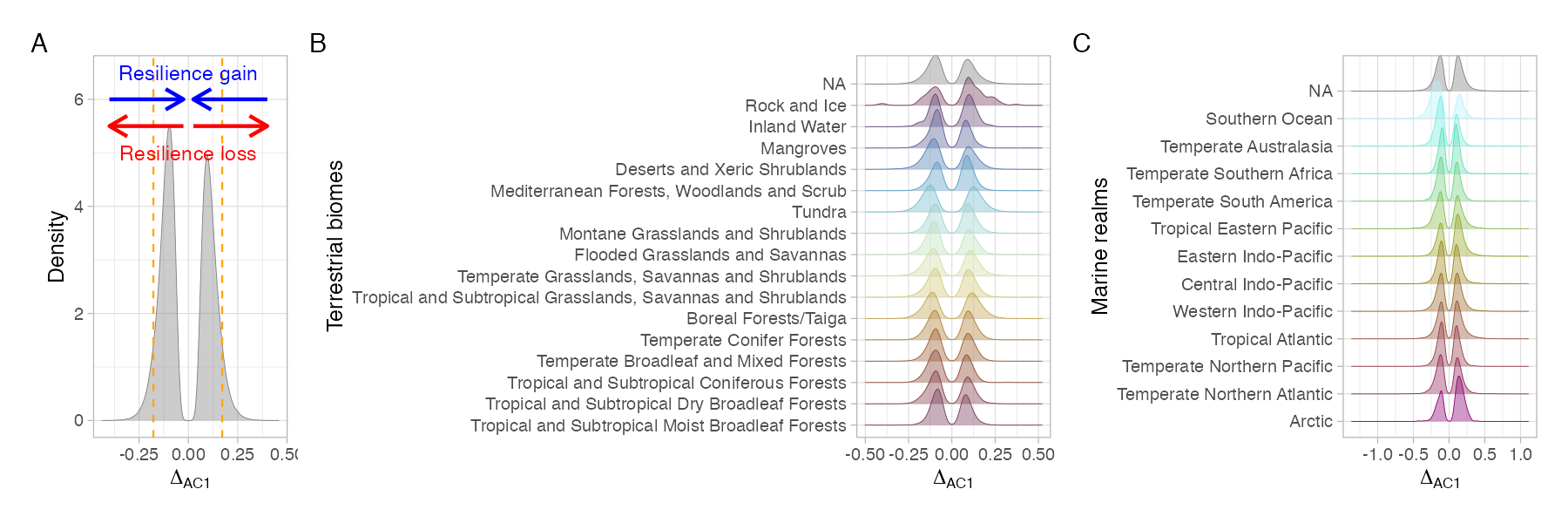
In the absence of ground truth, if Δ is > 95% or < 5% of the distribution is considered a signal of resilience loss
Gross primary productivity
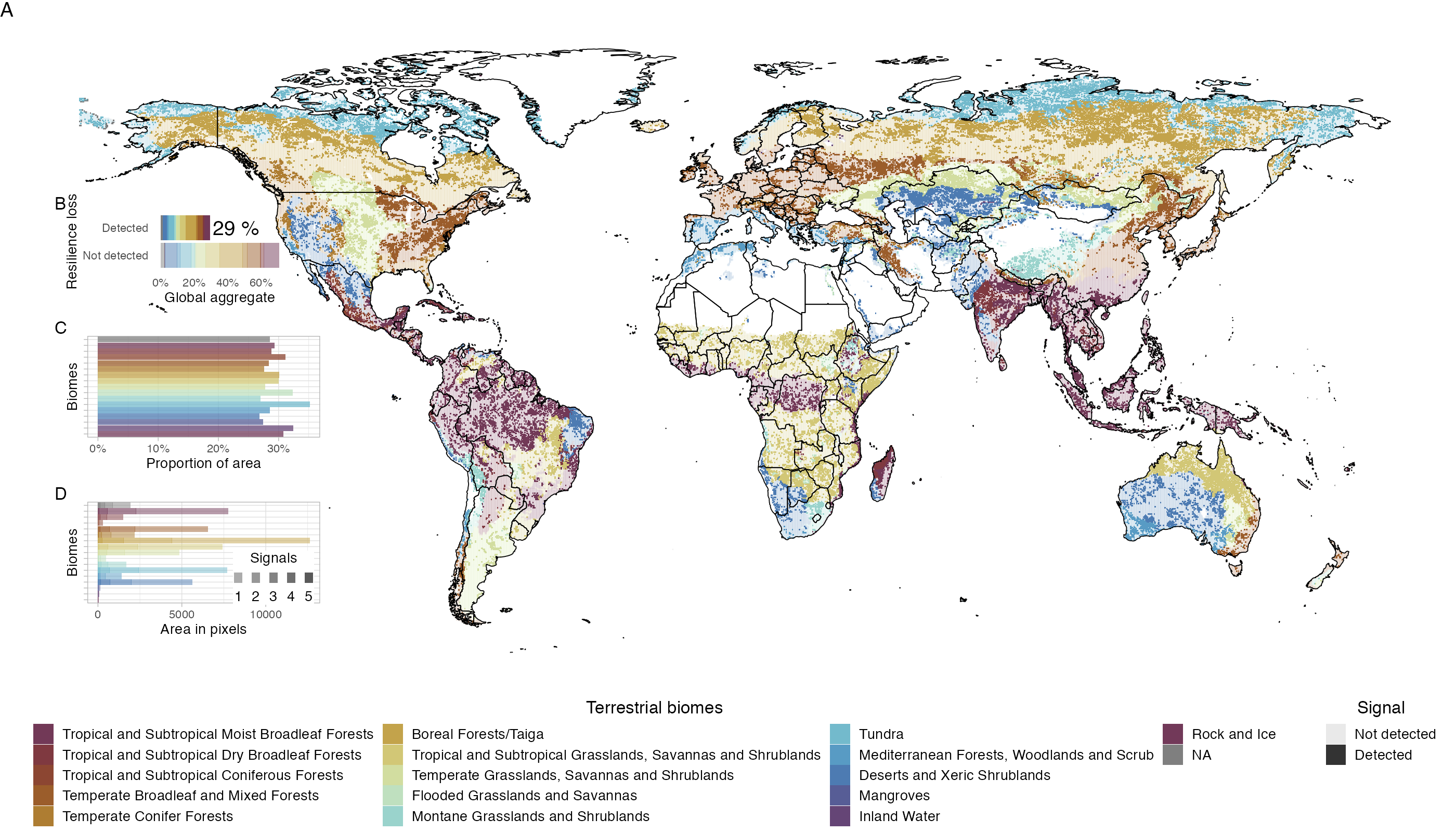
~30% of ecosystem show symptoms of resilience loss, boreal forest and tundra particularly strong signals
Chlorophyll A
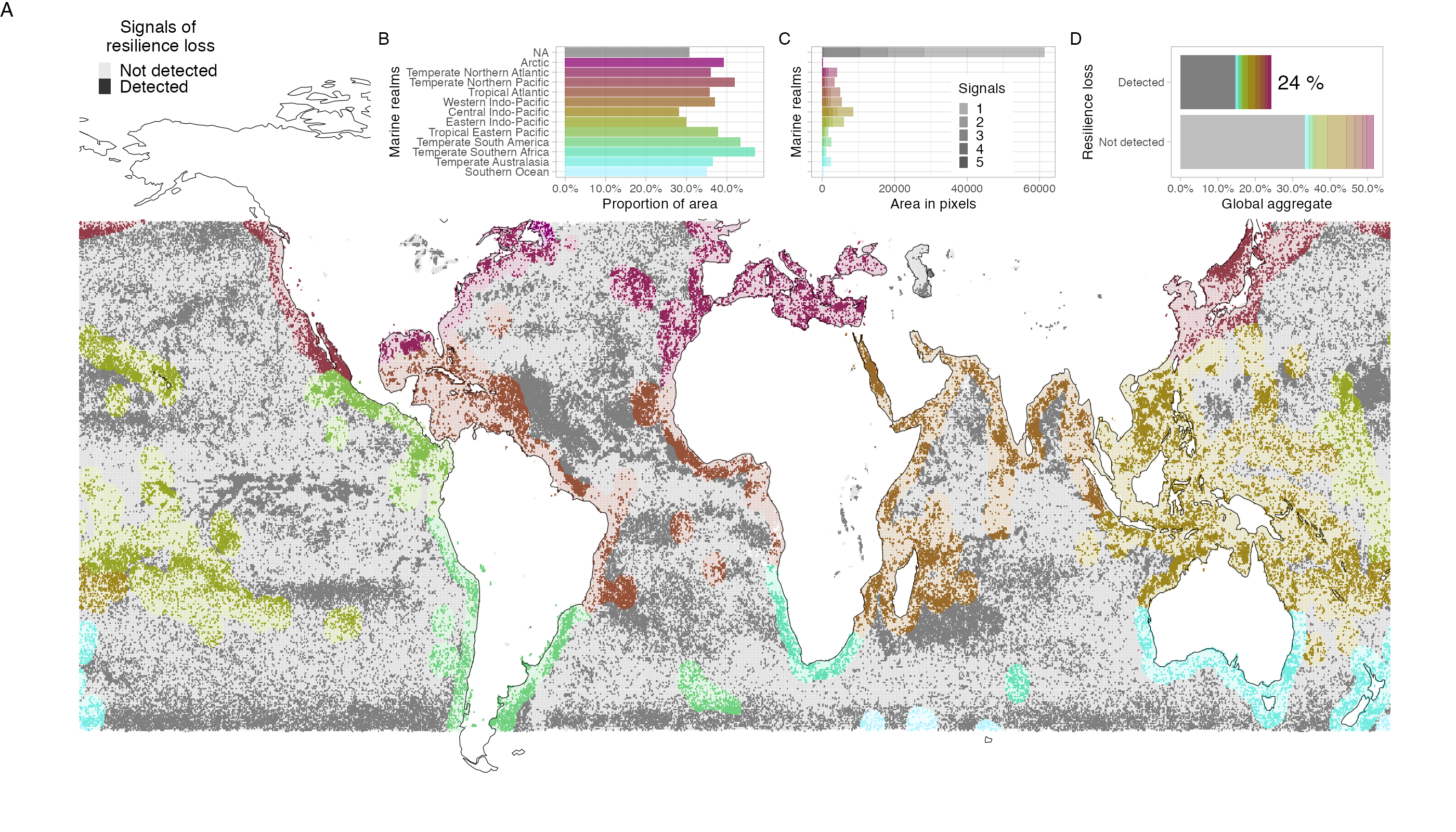
~25% of ecosystem show symptoms of resilience loss, Easter Indo-Pacific and Tropical Eastern Pacific Oceans particularly strong signals
Next steps
- Identify who has agency to make a difference
- Identify if the symptoms in one place are related to symptoms elsewhere: empirical evidence of cascading effects
- Use the network structure to manage and avoid escalating crises
Summary
- Regime shifts are large, abrupt and persistent changes
- They occur when tipping points are crossed
- Tipping points can interact
- Regime shifts can be interconnected
- Identifying where, when and by whom can help us manage their risk: businesses have an important role to play in taking care of 🌎
Tack | Gracias
Questions?
email: juan.rocha@su.se
twitter: @juanrocha
slides: juanrocha.se/presentations/interacting_tipping




